
20
Jul
(Beyond Pesticides, July 20, 2016) Farmers and land managers across the U.S. are being encouraged to plant pollinator habitat adjacent to farmlands to provide shelter and food for pollinator species. But according to a new study published last week, these conservation areas still put bees at risk for pesticide contamination, as they fail to provide spatial or temporal relief. This study emphasizes that meaningful solutions to reversing pollinator decline does not lie with focusing on planting pollinator habitat, but ensuring that these refuge areas are free from pesticide contamination, highly toxic to bees and other pollinators, and reducing the reliance on toxic chemical inputs in agriculture and other landscapes.
 The study, “Neonicotinoid-contaminated pollinator strips adjacent to cropland reduce honey bee nutritional status,” finds that pollinator habitat adjacent to agricultural areas not only becomes a source for pesticide, especially neonicotinoid, exposures, but also poses significant risk to honey bees. The authors, Christina Mogren, PhD, and former USDA entomologist, Jonathan Lundgren, PhD, initially sought to study whether increasing forage by planting pollinator habitat in an agricultural-dominated region would serve to buffer against the harmful effects of plant-incorporated pesticides. However, the authors note that it soon became apparent that the unintended consequence was that these planted habitats become a source for neonicotinoid exposure.
The study, “Neonicotinoid-contaminated pollinator strips adjacent to cropland reduce honey bee nutritional status,” finds that pollinator habitat adjacent to agricultural areas not only becomes a source for pesticide, especially neonicotinoid, exposures, but also poses significant risk to honey bees. The authors, Christina Mogren, PhD, and former USDA entomologist, Jonathan Lundgren, PhD, initially sought to study whether increasing forage by planting pollinator habitat in an agricultural-dominated region would serve to buffer against the harmful effects of plant-incorporated pesticides. However, the authors note that it soon became apparent that the unintended consequence was that these planted habitats become a source for neonicotinoid exposure.
In testing for clothianidin, the neonicotinoid most widely used to coat corn and soybean seeds planted across farmlands in much of the U.S., residues were ubiquitous in leaf tissue and honey. Higher levels of clothianidin were detected in nectar collected by bees. One major caveat emerging from this study was that levels of clothianidin in habitat adjacent to organic fields had similar residues in leaf tissues and honey when compared to areas with coated seeds, with the exception of bee bread which had lower levels. Clothianidin-coated seeds are not permitted in certified organic production. Although organic farmers take precautions to limit the extent of pesticide drift and contamination trespassing unto their harms, this study finds that these precautions apparently fail to sufficiently protect from pesticide contamination, and that habitat near organic farms may not provide sufficient refuge for pollinators with widespread chemical-intensive agriculture.
According to the study, clothianidin uptake in plants within designated pollinator habitat was the same at treated and untreated sites, and is present in plants tissues throughout the growing season. The residues detected were at levels that impair the reproductive potential of honey bee queens and impact hive overwintering success. Drs. Mogren and Lundgren conclude that the placement of designated pollinator habitats needs to be carefully considered, given the study shows that these areas set aside for conservation do not provide spatial or temporal relief from neonicotinoid exposures in agricultural regions where their use is largely prophylactic. “In all likelihood, reducing bee exposures to these pesticides will require reductions in their use across the landscape and a movement away from prophylactic applications towards more integrated pest management strategies…”
The findings of this study challenge one of the central recommendations in  the recent  White House Pollinator Protection Action Plan, which focuses primarily on planting pollinator habitats, particularly in agricultural areas, urging farmers and land managers to use best management practices to minimize impacts to bees. Little to no mention was made about addressing pesticides known to be highly toxic to bees and other pollinators. Until there is a shift from continued and pervasive pesticide use across all landscapes, bees and other pollinators will continue to be at risk. A recent government-sponsored survey, conducted by Bee Informed reports that beekeepers lost 44 percent of their colonies between April 2015 and April 2016. Bee losses continue to be elevated and unsustainable.
Pesticides have been identified as a major contributing factor in pollinator decline and both the U.S. Environmental Protection Agency (EPA) and the U.S. Department of Agriculture (USDA) lead federal efforts to reverse the decline and restore healthy populations. However, very little meaningful action has been taken to address pesticide impacts on pollinators, and industry groups have been working to weaken and derail any pesticide reforms at state and local levels that may protect pollinators. Even a recent Government Accountability Office (GAO) report finds that USDA and EPA are not doing enough to protect pollinators. EPA has made some pesticide label amendments and proposals to restrict pesticide use under certain conditions however beekeepers and activists say these measures are not enough. Currently EPA is reviewing the neonicotinoid class of pesticides, found to be highly toxic to honey bees and linked to numerous bee die-offs and bee impairments. Its preliminary pollinator assessment for imidacloprid earlier this year identified several risks to bees, including use on cotton and citrus crops. Assessments for the other neonicotinoids are due out later this year.
In light of the  shortcomings of federal action  to protect these beneficial organisms, it is left up to us to ensure that we provide safe havens for pollinators by creating pesticide-free habitat and educating others to do the same.  Take action by calling on EPA to suspend neonicotinoids now. You can also declare your garden, yard, park or other space as pesticide-free and pollinator friendly. It does not matter how large or small your pledge is, as long as you contribute to the creation of safe pollinator habitat.  Sign the pledge today! Need ideas on creating the perfect pollinator habitat? The  Bee Protective Habitat Guide  can tell you which native plants are right for your region. For more information on what you can do, visit our  BEE Protective  page.
All unattributed positions and opinions in this piece are those of Beyond Pesticides.
Source: Nature.com
Posted in Agriculture, Alternatives/Organics, Announcements, Increased Vulnerability to Diseases from Chemical Exposure, Persistence, Pollinators by: Beyond Pesticides
No Comments
19
Jul
(Beyond Pesticides, July 19, 2016) Exposure to common pesticides at levels often found in the environment can have subtle but significant impacts on the behavioral health of fish, amphibians and other aquatic invertebrates. According to researchers at Northern Arizona University, who analyzed data from nearly 40 experiments to reach their conclusion, fish and amphibians swam 35% slower and were 72% less active after pesticide exposure.
The study, published in Science of the Total Environment, found that the overall effect on aquatic wildlife varied based on the chemical class the animals encountered. While pyrethroids, carbamates, and organophosphates resulted in a significant decrease in swim speed, triazines and phosphonoglycines showed no overall effect. Pyrethroids, carbamates, organophosphates, organochlorines, and organotins decreased activity, while phosphonoglycines had no overall effect, and triazines actually increased activity. “I didn’t think that we would see [an effect] across such a wide range of pesticides so consistently, but we did,” said study co-author, Catherine Propper, PhD to KNAU, “and that leads to some concerns about environmental exposure for organisms.”
Changes in swim speed and activity level of fish and amphibians can have profound implications for their overall fitness in the environment. Authors of the analysis cite several studies linking specific sublethal pesticide exposures to reduced health outcomes. For example, one study finds reduced activity levels in flathead minnows after exposure to a pyrethroid can result in higher predation and slower growth rates. Salmon exposed to carbamates and organophosphates result in reduced growth, feeding, and size at the time of their migration. Other studies find that pesticide-induced decreases in activity can result in reduced predation on amphibians, but at the cost of reduced growth and delayed development.
The effects of pesticide exposure can alter 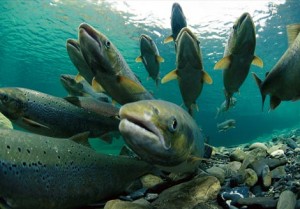 species interactions, and potentially create trophic cascades, situations where the interaction between predators and prey in the food web becomes imbalanced. For example, a predacious fish may, under normal circumstances, exert a population control on smaller fish that feed on insects that eat algae. Decreased activity and reduced predation among predacious fish can result in an explosion of smaller fish, which can then result in an overconsumption of algae-eating insects, ultimately leading to an increase in algae in an aquatic area. These difficult to perceive interactions underscore the call from the authors of the study for future research to better understand how pesticide-induced changes in behavior can alter the fitness, populations, and make-up of aquatic communities and ecosystems.
species interactions, and potentially create trophic cascades, situations where the interaction between predators and prey in the food web becomes imbalanced. For example, a predacious fish may, under normal circumstances, exert a population control on smaller fish that feed on insects that eat algae. Decreased activity and reduced predation among predacious fish can result in an explosion of smaller fish, which can then result in an overconsumption of algae-eating insects, ultimately leading to an increase in algae in an aquatic area. These difficult to perceive interactions underscore the call from the authors of the study for future research to better understand how pesticide-induced changes in behavior can alter the fitness, populations, and make-up of aquatic communities and ecosystems.
The varying interactions as a result of sublethal exposure from a range of common pesticide classes highlights the need for the U.S. Environmental Protection Agency (EPA) to re-evaluate its methodology for analyzing the impacts of these chemicals. As it stands, EPA’s review of pesticide ingredients fails to account or deems negligible difficult to perceive impacts on wildlife, such as changes in behavior or endocrine disruption. Instead, the agency relies on an outdated toxicological approach focused on acute effects, and the 16th-century maxim that “the dose makes the poison.” Independent science continues to tell us otherwise; the effects of these chemicals in the real world are much more complex than the scope of our regulatory system under EPA.
For more information on the impacts of pesticides on wildlife, and what you can do to reverse biodiversity declines, see Beyond Pesticides new Wildlife program page. Â There you can find out not only the ecological impacts of pesticides, but the add-on effect these situations create for your wallet, and the litigation underway to save threatened and endangered species. Additional information about pesticides and aquatic environments can be found on the Threatened Waters program page.
All unattributed positions and opinions in this piece are those of Beyond Pesticides.
Source: KNAU, Science of the Total Environment
Posted in Agriculture, Announcements, Chemicals, Pesticide Drift, Pesticide Residues, Wildlife/Endangered Sp. by: Beyond Pesticides
No Comments
18
Jul
(Beyond Pesticides July 18, 2016) A  review of the scientific literature links  glyphosate, one of the most popular weed killers in the U.S. and the active ingredient in Roundup, to a wide range of diseases through a mechanism that modifies DNA functioning, adding a new even more troubling dimension to the herbicide’s cancer classification by the International Agency for Research on Cancer. According to the most recent review, Glyphosate pathways to modern disease V: Amino acid analogue of glycine in diverse proteins, conducted by independent scientists Anthony Samsel, Ph.D. and Stephanie Seneff, Ph.D., a scientist at Massachusetts Institute of Technology (MIT), glyphosate acts as a glycine analogue that  incorporates into peptides during protein synthesis. In this process, it alters a number of proteins that depend on conserved glycine for proper function. According to the authors, glyphosate substitution for glycine correlates with  several diseases, including diabetes, obesity, asthma, Alzheimer’s disease, amyotrophic lateral sclerosis (ALS), and Parkinson’s disease, among others.
Glycine, the smallest amino acid commonly found in proteins, has unique properties that support flexibility and the ability to anchor to the plasma membrane or the cytoskeleton.  This new direct biological evidence, taken together with correlational data, make a compelling case that glyphosate action as a glycine analogue accounts for much of glyphosate’s toxicity, according to the study. The authors find that glyphosate, as an amino acid analogue of  glycine, may  be  incorporated into polypeptide chains during protein synthesis. In doing so, it has an impact on the structure and function of the proteins. Proteins fold up, and glycine is a small molecule that is often found at the folding places. Since glyphosate is much larger, it prevents the protein molecule from folding properly, leading to the disruption of function of many  proteins with essential roles in metabolism and regulatory processes.
The article cites a  number of ways that this affects humans and other organisms. According to the study, the consequences of this action can lead to impaired fatty acid release leading to obesity, impaired insulin receptor response leading to diabetes, impaired one-carbon metabolism leading to neural tube defects and autism, impaired cell cycle control during DNA synthesis, and disregulated phosphorylation cascades leading to cancer, lung disorders, and autoimmune diseases.
Stephen Frantz, Ph.D., a pathobiologist research scientist explains it like this: “When a cell is trying to form proteins, it may grab glyphosate instead of glycine to form a damaged, mis-folded protein. After that it’s medical chaos. Where glyphosate replaces glycine, the cell can no longer conduct business as usual causing unpredicted consequences with many diseases and disorders as a result.”
The release of this study comes on the heels of several other discussions and actions on glyphosate that have taken place over the past few weeks. Last month at a Congressional briefing sponsored by U.S Representative Ted Lieu, a delegation of independent scientists including this study’s authors, presented their findings, urging lawmakers to call on the EPA to ban RoundUp, Monsanto’s flagship herbicide. Beyond Pesticides participated on the panel, providing testimony on the impact of glyphosate on soil systems, as well as the unreasonable risk it poses to humans, animals, and the environment. Following the congressional briefing, scientists spoke at a closed meeting with the Environmental Protection Agency (EPA), explaining the biochemical and physiological reasons why exposure to glyphosate, the active ingredient in RoundUp, is linked to autism, Alzheimer’s, cancer, birth defects, obesity, and gluten intolerance, among other health issues. EPA’s Office of Pesticide Programs’ Deputy Director and his staff met with the panelists and provided an overview of EPA’s registration process for glyphosate. EPA staff had some interest in the information presented, which was forwarded to relevant staffers. However, EPA indicated that much of the information provided may not impact their current risk assessment for glyphosate, which is expected sometime in 2017.
Glyphosate, created by Monsanto, is touted as a “low toxicity” chemical and “safer” than other chemicals by industry. But glyphosate has been shown to have  detrimental impacts  on humans and the environment. Given its widespread use on residential and agricultural sites, its toxicity is of increasing concern. In early 2015, glyphosate was classified by the World Health Organization’s (WHO) International Agency for Research on Cancer (IARC) of as a “probable human carcinogen.”  Just a few months later, a study published in  Environmental Health News  found that  chronic, low-dose exposure to glyphosate  led to adverse effects on liver and kidney health. Roundup formulations can also induce a dose-dependent formation of DNA adducts (altered forms of DNA linked to chemical exposure, playing a key role in chemical carcinogenesis) in the kidneys and liver of mice. Human cell endocrine disruption on the androgen receptor, inhibition of transcriptional activities on estrogen receptors on HepG2, DNA damage and cytotoxic effects occurring at concentrations well below “acceptable” residues have all been observed.
Roundup also harms crops’ ability to capture carbon from the air, an important factor in fighting climate change. “Glyphosate negatively affects the soil microbiome,” said Frantz. “It is destroying the ability of soil to be a nutritive medium for producing crops. Organic or biological regenerative agriculture is the solution for the sustainable agricultural sector and will conserve soil, air and water quality, and sequester carbon that helps to mitigate the climate crisis. We call for a ban on glyphosate.”
Beyond Pesticides urges individuals concerned about glyphosate exposure to support organic systems that do not rely on hazardous carcinogenic pesticides. In agriculture, concerned consumers can  buy food with the certified organic label, which not only disallows synthetic pesticides like glyphosate, but also the use of sewage sludge and genetically engineered ingredients. Beyond Pesticides also urges the adoption of  organic lawn and landscape programs.
All unattributed positions and opinions in this piece are those of Beyond Pesticides.
Source: Research Gate, Huffington Post
Posted in Agriculture, Alternatives/Organics, Announcements, Chemicals, Disease/Health Effects, Glyphosate by: Beyond Pesticides
5 Comments
15
Jul

Image from NASA
(Beyond Pesticides, July 15, 2016) A toxic algae bloom that has expanded throughout Florida’s largest freshwater body, Lake Okeechobee, and around south Florida beaches, has created vast problems for residents, compelling Governor Rick Scott to declare an environmental state of emergency.  However, the Governor’s  declaration fails to address the root of the problem””including the extreme levels of nutrient buildup and the dangerous amount of phosphorous and nitrogen found in the water, caused by excess fertilization runoff from both chemically-intensive agricultural and residential sources. Instead, Gov. Scott has placed blame on the federal government due to their lack of proper maintenance on the Herbert Hoover Dike, which prevents Lake Okeechobee from overflowing into nearby water sources. While this is certainly problematic, the crux of the issue stems from the polluted water itself, which allows bacteria to grow swiftly when nutrients like phosphorus and nitrogen are abundant.
“We just are putting way too much nitrogen and phosphorus into our natural waters, and they respond,” Florida Atlantic University research professor, Bill Louda, Ph.D. told CBS news.
A few weeks ago, the U.S. Army Corps of Engineers, Jacksonville District, as a means of flood prevention,  released  the lake’s water  into local canals  with a  large amount of nutrient pollution. Jackson Kirk of the U.S. Army Corps of Engineers, stated, “Part of our mitigation to prevent a breach situation includes managing the water level in the lake to keep it from rising too high. Unfortunately, this requires releasing water in quantities that, when combined with an equally large volume of basin runoff, upset the freshwater-saltwater mix in the estuaries. The change in that mix, coupled with hot weather, and excessive nitrogen and phosphorus in the system from a variety of sources, are all among the factors fueling the algae affecting the estuaries.” The U.S. Army Corps of Engineers, Jacksonville district, released a statement on July 14  stating they “will further reduce the amount of water flowing from Lake Okeechobee beginning this weekend.”
This algae bloom, which, according to NASA grew to cover 33 square miles as of May 2016, has been called “unprecedented” by many of Florida officials. In reality, this type of occurrence has been on the rise over the past few years throughout the country. Similar to the algal blooms that occurred in Lake Erie back in 2013, Lake Okeechobee is both extremely shallow, averaging about 9 feet deep, warm, and surrounded by industrial agricultural land, making its water more prone to this type of algal bloom. Hotter and more frequent extreme weather events alongside harmful trends in chemically-intensive, conventional agricultural practices have caused these destructive algal blooms to strike more frequently in these types of waterbodies.
“Basically, we are fertilizing Florida to death,” Dr. Louda told Huffington Post. “You could throw some nasty herbicides or synthetic inhibitors on top of it, but it would kill everything else too, the seagrass, the phytoplankton fish eat. We just have to let nature take its course.” Dr. Louda, who is based  in  Boca Raton, has been studying and testing the algae.
Fertilizer runoff not only causes what many news outlets are describing as the smelly “guacamole thick” toxic algal blooms, it can also severely harm humans and aquatic wildlife. An unnaturally high level of phosphorous in aquatic ecosystems creates a setting that compromises the diversity, stability, and resiliency of the natural environment. Once algae die off, aerobic bacteria consume the dead algae, resulting in dangerously low oxygen “dead zones,” which further decrease  biodiversity. In a study done by Environment America, agribusiness pollution is a leading cause of dead zones that plague waters all over the United States, estimating “manure footprints” of major agribusiness companies. The manure that is generated as waste by these companies is put on crop land, leading to run off issues.
Furthermore, the U.S. Environmental Protection Agency (EPA), alongside many environmental advocates and scientists, believe climate change impacts have begun to make these type of conditions in which blooms thrive a common occurrence.
Community members and those visiting the affected areas have also voiced frustration and concern over the known health effects associated with exposure to toxic algae. Many report experiencing symptoms such as headaches and respiratory problems that they believe are linked to the outbreak. The Florida Department of Environmental Protection has been consistently monitoring the blooms and urges residents to report new blooms.
Audubon Florida, an environmental group, recommends multiple long-term solutions to protect the health of Lake Okeechobee and surrounding waters, including an update to the state’s Basin Management Action Plan (BMAP) to fully address the scope of the negative water quality as a result of unnaturally high nutrient levels. It also recommends more focus on monitoring and enforcement of on-farm Best Management Practices (BMPs), which is a step in the right direction, but  falls short of organic standards.
Organic farming and land management uses natural, less soluble sources of nitrogen, phosphorous and magnesium; including cover crops, compost, manure and mineralized rock,  in order to promote increases in soil organic matter and a healthy soil structure. Healthy soil structure allows water to infiltrate the ground slowly, rather than escaping across the surface and carrying soil particles, nutrients, and other inputs with it. Also, it allows plants to establish vibrant root systems that resist erosion. For more details, see Beyond Pesticides fact sheet, Organic Land Management and the Protection of Water Quality. In addition to agricultural practices, residential use of lawn care fertilizers represents a significant portion of the phosphorous load that runs into local water bodies in the U.S. For more details on how to prevent phosphorous contamination, see Beyond Pesticides’ article  Maintaining a Delicate Balance.
For further resources on pesticides and water quality, please visit Beyond Pesticides’ Threatened Waters  page.
Sources: NASA, CBS News, Huffington Post
All unattributed positions and opinions in this piece are those of Beyond Pesticides.
Posted in Agriculture, Announcements, Florida, Invasive Species, State/Local, Water by: Beyond Pesticides
No Comments
14
Jul
(Beyond Pesticides, July 14, 2016) A funding bill (H.R. 5538) for the Environmental Protection Agency (EPA) and Interior Department is receiving pushback from conservation groups, environmental lobbyists, and workers’ rights advocates for containing dozens of controversial amendments, including  one that would strip funding for parts of the Agricultural Worker Protection Standard (WPS), which establishes many  protections for  those  in the country who experience the highest and most dangerous pesticide exposure — farmworkers.
 Title IV, Section 437 of H.R. 5538 states that, “None of the funds made available by this or any other Act may be used to implement or enforce, or to require States to implement or enforce, the provisions of 40 CFR 170.311(b)(9) as published in the Federal Register on November 2, 2015.” The provisions of 40 CFR 170.311(b)(9) refer to the WPS revisions passed in 2015, which had previously not been updated for over 20 years. The revisions are designed to provide at least some protections from pesticide exposure to farmworkers and their families is scheduled to effect in  December 2016.
Title IV, Section 437 of H.R. 5538 states that, “None of the funds made available by this or any other Act may be used to implement or enforce, or to require States to implement or enforce, the provisions of 40 CFR 170.311(b)(9) as published in the Federal Register on November 2, 2015.” The provisions of 40 CFR 170.311(b)(9) refer to the WPS revisions passed in 2015, which had previously not been updated for over 20 years. The revisions are designed to provide at least some protections from pesticide exposure to farmworkers and their families is scheduled to effect in  December 2016.
Historically, farmworker advocates have criticized  WPS as woefully inadequate in protecting the health of agricultural workers, but these new revisions strengthen the standards through increased training for workers handling pesticides, improved notification of pesticide applications, and a higher  minimum age requirement for children to work around pesticides.
According to a factsheet released by Farmworker Justice, a nonprofit organization that represents the interests of  migrant and seasonal farmworkers, “Title IV, Section 437 of the FY 2017 House Appropriations Bill for the Interior, Environment, and Related Agencies would prohibit ”˜the use of funds to implement or enforce,’ the provisions of the WPS that allow access to pesticide application and hazard information by a worker’s designated representative. By denying access to such information to a designated representative, Congress would create barriers that could delay medical treatment and add more to healthcare costs. The idea that workers should not be able to designate representatives is unacceptable.”
Farm work is demanding and dangerous physical labor. As the scientific literature confirms, farmworkers, their families, and their communities face extraordinary risks from pesticide exposures. Application and pesticide drift result in dermal, inhalation, and oral exposures that are typically underestimated. A 2004 study detected agricultural pesticides in the homes near to agricultural fields. According to a 2010 study, workers experience repeated exposures to the same pesticides evidenced by multiple pesticides routinely detected in their bodies. As a result of cumulative long-term exposures, farmworkers  and their children, who often times also work on the farm, are at risk of developing serious chronic health problems such as cancer, neurological impairments, and Parkinson’s disease. Children, according to an  American Academy of Pediatrics (AAP) report, face even greater health risks compared to adults when exposed to pesticides. For more information, read our factsheet, Children and Pesticides Don’t Mix.
We need Congress to reject this attack on farmworker health and safety. Please urge your member of Congress to vote “no” on H.R. 5538.
What More Can We Do?
Our food choices have a direct effect around the world on those who grow and harvest the food we eat around. This is why  food labeled organic  is the right choice. In addition to serious health questions linked to actual residues of toxic pesticides on the food we eat, our food buying decisions support or reject hazardous agricultural practices, and the protection of farmworkers and farm families. See Beyond Pesticides’ guide to  Eating with a Conscience  to see how your food choices can protect farmworkers. In addition to organic, it is also important to consider food labels that create standards for farmworker safety and fairness. For more information on the different types of food labels, including the Agricultural Justice certification  label, see the transcription of Michael Sligh’s talk at the 32nd National Pesticide Forum, titled Social Justice Labeling: From Field to Table.
For more information on Agricultural Justice, and how you can make a difference, see the Agricultural Justice Initiatives Panel from the 33rd National Pesticide Forum.
All unattributed positions and opinions in this piece are those of Beyond Pesticides.
Source: H.R. 5538; Bloomberg BNA
Posted in Agriculture, Announcements, Farmworkers, National Politics, Take Action by: Beyond Pesticides
1 Comment
13
Jul
(Beyond Pesticides, July 13, 2016) California’s Office of Environmental Health Hazard Assessment (OEHHA) has announced that atrazine, its chemical cousins,  propazine,  simazine,  and its break down triazine compounds des-ethyl atrazine (DEA),  des-isopropyl atrazine (DIA)  and  2,4-diamino-6-chloro-s-triazine (DACT)  would be added to the list of chemicals known to the state to cause reproductive toxicity for purposes of the state’s Proposition 65. The formal listing has been delayed and will not be effective until July 15, 2016 due to litigation from the manufacturer, Syngenta, which opposes the listing.
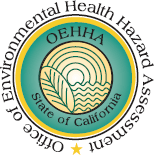 In 2014 the state announced its Notice of Intent to list the triazines: atrazine, propazine, simazine and their breakdown products under Proposition 65 — the state’s law on toxic chemicals. The listing of these chemicals was initially to be effective on August 3, 2015. However, Syngenta, manufacturer of atrazine, challenged the listing decision, leading to a delay in the formal decision. Syngenta Crop Protection v OEHHA  (Sacramento Superior Court case#34-2014-800001868). Syngenta’s challenge was unsuccessful and now the official listing can move forward, in spite of Syngenta’s pending appeal. The six chemicals will now be known as reproductive toxicants in the state of California effective July 15, 2016. See listing notice. http://oehha.ca.gov/media/downloads/crnr/listingnoticetriazines070516.pdf
In 2014 the state announced its Notice of Intent to list the triazines: atrazine, propazine, simazine and their breakdown products under Proposition 65 — the state’s law on toxic chemicals. The listing of these chemicals was initially to be effective on August 3, 2015. However, Syngenta, manufacturer of atrazine, challenged the listing decision, leading to a delay in the formal decision. Syngenta Crop Protection v OEHHA  (Sacramento Superior Court case#34-2014-800001868). Syngenta’s challenge was unsuccessful and now the official listing can move forward, in spite of Syngenta’s pending appeal. The six chemicals will now be known as reproductive toxicants in the state of California effective July 15, 2016. See listing notice. http://oehha.ca.gov/media/downloads/crnr/listingnoticetriazines070516.pdf
Proposition 65, officially known as the  Safe Drinking Water and Toxic Enforcement Act of 1986, was enacted as a ballot initiative in November 1986. The proposition protects the state’s drinking water sources from being contaminated with chemicals known to cause cancer, birth defects or other reproductive harm, and requires businesses to inform Californians about exposures to such chemicals.
According to OEHHA, the determination to list atrazine and the other triazines is based on the findings of several previous U.S. Environmental Protection Agency (EPA) documents which conclude that they cause developmental and reproductive effects through a common mechanism of toxic action. Some of these cited EPA documents include, ”˜Triazine Cumulative Risk’ (2006); 2006 Decision Documents for Atrazine, ”˜Reregistration Eligibility Decision Document for Simazine’  (2006) and ”˜Propazine: Revised HED [Health Effects Division] Risk Assessment for the Tolerance Reassessment Eligibility Decision Document’  (2005). Further, EPA established several reference doses (maximum acceptable oral dose) on the basis of reproductive and developmental toxicity, relying on endpoints that included impacts on the endocrine system and physical malformations.
Specifically, 2006 EPA’s Cumulative Risk Assessment on the triazines states, “The underlying mechanism of the endocrine-related changes associated with atrazine and similar triazines is understood to involve a disruption of the hypothalamic-pituitary-gonadal (HPG) axis”¦ In particular, the triazine-mediated changes in the HPG relating to neuroendocrine and neuroendocrine-related developmental and reproductive toxicity are considered relevant to humans, and these adverse effects were identified as endpoints for the exposure scenarios selected for consideration in the quantitative cumulative assessment.” (p. 4) OEHHA explains that based on the evidence reviewed from EPA’s findings the requirements for Prop 65 listing have been met.
California’s Prop. 65 is the only law in the nation to prohibit businesses from knowingly and intentionally exposing consumers to a chemical known to the state to cause cancer or reproductive harm without first providing a warning. Violations are subject to potential penalties of up to $2,500 per day for each violation, and each sale can constitute a violation. Prevailing plaintiffs can also recover their attorneys’ fees.
In addition to atrazine and its cousin’s impact on human health, their impact on environmental health is also well documented.  Just last month EPA released its triazine ecological risk assessment, which found that these chemicals pose risks to fish, amphibians, aquatic invertebrates, and even birds, reptiles and mammals. The assessments evaluated risks to animals and plants including, amphibians, birds, mammals, fish, reptiles, aquatic invertebrates, aquatic plant communities, and terrestrial plants. For atrazine, EPA concludes, “aquatic plant communities are impacted in many areas where atrazine use is heaviest, and there is potential chronic risks to fish, amphibians, and aquatic invertebrate in these same locations. In the terrestrial environment, there are risk concerns for mammals, birds, reptiles, plants and plant communities across the country for many of the atrazine uses.” Levels of concerns were exceeded by as much as 200-fold for some organisms! When it comes to amphibians, impacts which have been  extensively documented  by researchers like Tyrone Hayes, PhD, at the University of California, Berkeley, EPA finds that “there is potential for chronic risks to amphibians based on multiple effects endpoint concentrations compared to measured and predicted surface water concentrations.” Previous scientific reviews, like the  2009 analysis of more than 100 scientific studies  conducted on atrazine, found evidence that atrazine harms fish and frogs. All three chemicals are mobile and persistent in the environment, which results in water contamination. According to the U.S. Geological Survey (USGS), atrazine is one of the most frequently detected pesticides,  found at concentrations at or above aquatic benchmarks, and is also frequently detected in shallow ground water.
Studies by Dr. Hayes  and others have shown that concentrations as little as 0.1ppb impact hormone function in organisms and turns tadpoles into hermaphrodites — creatures with both male and female sexual characteristics. Research also finds that atrazine interferes with mammary gland development in the breast of mammals and is  linked to certain birth defects  like gastroschisis and choanal atresia, which are significantly increased for pregnant women with high levels of atrazine exposure in agricultural areas, and in urban streams.
EPA is currently in the registration review process for these chemicals, and the draft ecological assessments are now  open for public comment until August 5, 2016. EPA will have atrazine’s assessment peer reviewed by the Scientific Advisory Panel in 2017. Submit your comments for Atrazine (EPA-HQ-OPP-2013-0266), Simazine (EPA-HQ-OPP-2013-0251) and Propazine (EPA-HQ-OPP-2013-0250) by October 4, 2016 at the federal docket. https://www.regulations.gov/comment?D=EPA-HQ-OPP-2015-0794-0005
All unattributed positions and opinions in this piece are those of Beyond Pesticides.
Source: OEHHA
Posted in Announcements, Atrazine, Chemicals, Corporations, Disease/Health Effects, Litigation, National Politics, Pesticide Regulation, Reproductive Health, Syngenta by: Beyond Pesticides
No Comments
12
Jul
(Beyond Pesticides, July 12, 2016) Canadian environmental organizations sued the  Canadian Pest Management Regulatory Agency (PRMA) last week in a bid to overturn the approval of two neonicotinoid pesticides linked to the decline of honey bees and wild pollinators. The move comes amid growing awareness, action, and scientific evidence linking this widely used class of insecticides to the global decline of pollinator populations.
 The lawsuit, filed  by Ecojustice on behalf of  The David Suzuki Foundation, Friends of the Earth Canada, Ontario Nature, and the Wilderness Committee, argues that pesticide products containing two neonicotinoids, clothianidin and thiamethoxam, are unlawfully registered in Canada. The groups allege that PMRA failed to ensure that it had the data necessary to determine the environmental risks, particularly those concerning pollinators, posed by the chemicals. “The PMRA has taken a see-no-evil, hear-no-evil, speak-no-evil approach by repeatedly registering these neonicotinoid pesticides without important scientific information on their risks to pollinators,” said Charles Hatt, staff lawyer at Ecojustice.
The lawsuit, filed  by Ecojustice on behalf of  The David Suzuki Foundation, Friends of the Earth Canada, Ontario Nature, and the Wilderness Committee, argues that pesticide products containing two neonicotinoids, clothianidin and thiamethoxam, are unlawfully registered in Canada. The groups allege that PMRA failed to ensure that it had the data necessary to determine the environmental risks, particularly those concerning pollinators, posed by the chemicals. “The PMRA has taken a see-no-evil, hear-no-evil, speak-no-evil approach by repeatedly registering these neonicotinoid pesticides without important scientific information on their risks to pollinators,” said Charles Hatt, staff lawyer at Ecojustice.
Under Canada’s Pest Control Products Act, PMRA must have “reasonable certainty” that a pesticide will not cause harm to the environment before it is registered. The groups also note that several thiamethoxam-based products have been registered by the agency for years without a mandated public consultation period.
“Pollinators are key players in our ecosystems, and their declines are extremely concerning. A stunning variety of plants ”” including fruits, vegetables, nuts, and 90 per cent of flowering plants ”” need pollinators to reproduce and thrive,” said Anne Bell, PhD, Director of Conservation and Education at Ontario Nature.
Although PMRA has not taken substantial action to restrict neonicotinoids, certain Canadian provinces and cities have begun eliminating significant uses of these chemicals. Last year, Ontario became the first jurisdiction in North America to restrict the use of neonicotinoid coated seeds, limiting acreage planted with these toxic seeds by 80% by 2017. “The Province of Ontario recently  brought in strong  restrictions on the  use of  dangerous  neonicotinoid pesticides in agriculture,” said Faisal Moola, PhD, Director General of Ontario and Northern Canada at the David Suzuki Foundation. “We’re hoping that our  court case will  compel the federal government to take similar action  in response to widespread public concern over the fate of pollinators in Canada.” Neonicotinoid coated seeds have been implicated in massive bee kills as a result of “fugitive dust” that sloughs off and drifts during planting, contaminating bee-attractive plants nearby. A report by the American Bird Conservancy found that a single neonic-coated corn kernel was enough to kill a songbird. A study by the U.S. Environmental Protection Agency (EPA) found that neonicotinoid soybean seed treatments offered little to no benefit to farmers in terms of pest control or increased economic well-being.
Late last year, the Quebec city of Montreal moved to completely ban the use of neonicotinoids within the city, following similar moves in the U.S., where local governments in Minneapolis, MN, Lafayette and Boulder, CO, Portland, OR, Montgomery County, MD, and numerous other locations have restricted or eliminated the use of neonicotinoids on public and/or private property.
Federal action in the U.S to restrict neonicotinoids has been equally as lackluster as Canada’s response. Although federal agency have announced some pollinator protective measures as part of the National Pollinator Health Strategy, and EPA has acknowledged the neonicotinoid imidacloprid presents acute risks to pollinators, these moves have largely been seen as inadequate.  The agency continues to approve other bee-toxic pesticides, like sulfoxaflor, despite evidence showing unacceptable adverse impacts to pollinators, and court cases to back up these claims.
In 2013, Beyond Pesticides joined with beekeepers and environmental allies in a lawsuit similar to the one recently launched in Canada, challenging EPA’s approval of thiamethoxam and clothianidin. These highly toxic, persistent and systemic chemicals have been widely implicated as leading factors in pollinator declines. For a primer on the pollinator crisis, see the lawsuit’s Press Release. Also, read the 2013 Lawsuit, Appendix A: Clothianidin, and Appendix B: Thiamethoxam.
For more information on how you can take action to protect pollinators in your community, and advocate for change at the federal level, see Beyond Pesticides BEE Protective program page.
All unattributed positions and opinions in this piece are those of Beyond Pesticides.
Source: Commondreams.org, Montreal Gazette
Posted in Announcements, Chemicals, Clothianidin, Increased Vulnerability to Diseases from Chemical Exposure, International, Persistence, Pollinators, Thiamethoxam by: Beyond Pesticides
No Comments
11
Jul
(Beyond Pesticides, July 11, 2016) The Centers for Disease Control and Prevention (CDC) and the U.S. Environmental Protection Agency (EPA) announced last Wednesday, July 6 that Zika is spreading rapidly in Puerto Rico, and recommends aerial spraying of the toxic pesticide Naled for mosquito control, much to the dismay of many area farmers, activists and concerned citizens who feel that the decision was made without consultation or information provided to the local population. Aerial spraying of pesticides have long been used for mosquito control, but many experts believe that these methods fail to sufficiently manage mosquito populations, increase pesticide resistance, and kill other species that would have acted as a natural predator to mosquitoes. Many experts  agree that combating mosquito-borne diseases should include good surveillance and scientific understanding for controlling mosquito populations, including a focus on  eliminating or managing  breeding areas,  utilizing  biological controls, exclusion from indoor environments with screening, and repellents.
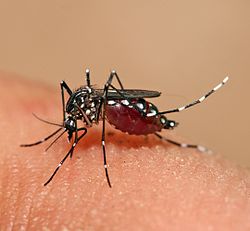 An efficient mosquito management strategy emphasizes public awareness, prevention, and monitoring methods. However, if these methods are not used properly or in time, communities must determine if they should risk exposing vulnerable populations to potentially harmful diseases caused by mosquitoes or to chronic or deadly illnesses caused by pesticides.
An efficient mosquito management strategy emphasizes public awareness, prevention, and monitoring methods. However, if these methods are not used properly or in time, communities must determine if they should risk exposing vulnerable populations to potentially harmful diseases caused by mosquitoes or to chronic or deadly illnesses caused by pesticides.
Note that mosquito-borne transmission of Zika virus has not been reported in the U.S., but has been found in U.S. “territories” – Puerto Rico, the U.S. Virgin Islands, and American Samoa, and other countries. The virus has been found in travelers to the U.S. from countries where infected mosquitoes have been reported.
The power struggle stems from the recent approval by the U.S. Congress and the signature of President Obama of the Puerto Rico Oversight, Management and Economic Stability Act (or PROMESA, meaning promise in Spanish), which has stripped the island of much of its autonomy. According to Workers World, Puerto Rican experts have proposed other, more appropriate ways to counter Zika, but the government has not listened to them, and several environmental, health, agriculture, social justice, and other organizations have banded together to create the United Front Against Aerial Fumigation in opposition to the spraying. There have also been numerous protests.
Puerto Rico’s Popular Democratic Party (PDP) President and gubernatorial candidate David Bernier has also been outspoken against the plan to aerially spray. According to Carribean Business, Mr. Bernier said that he was concerned about “the manner in which reports were made known to the public, mainly through unofficial channels and without any formal announcement on the matter, which prompted additional speculation and confusion.” He also cited concerns about the potential hazards it would have on the people’s health, the ecosystem, and specifically the many bodies of water.
According to EPA, Naled can cause cholinesterase inhibition in humans, meaning that it can overstimulate the nervous system causing nausea, dizziness, confusion, and at very high exposures (e.g., accidents or major spills), respiratory paralysis and death. Residents can be exposed as by-standers from wide-area mosquito control applications, such as what they are recommending. In the decision statement to consider Naled, CDC points to studies from earlier this year demonstrating that mosquitoes in Puerto Rico are resistant to all aerial formulations of pyrethroid insecticides. Naled and many other commonly used mosquito pesticides, such as  permethrin, resmethrin, and malation, are all associated with some measure of human and ecological health risks, especially among people with compromised immune systems, chemically sensitized people, pregnant women, and children with respiratory problems, such as asthma.
Furthermore, the efficacy of aerial and ground spraying of pesticides is questionable. Large-scale mosquito control applications are made with ultra-low volume (ULV) sprays that dispense very fine droplets of the pesticide product into the air. Only those mosquitoes that come in contact with the fine particles are killed. The sprayed pesticides do not affect mosquito larvae left behind, which spawn new adult mosquitoes, ensuring the need for subsequent spraying.
Beyond Pesticides’ Public Health Mosquito Management Strategy (see also  mosquito management strategy  summary) is  an integrated approach that emphasizes education, aggressive removal of standing water (which are breeding areas), larval control, monitoring, and surveillance for both mosquito-borne illness and pesticide-related illness. Control of disease-carrying mosquitoes can be successful when emphasis is placed on public education and preventive strategies.
Individuals can take action by eliminating standing water, introducing mosquito-eating fish, encouraging predators, such as bats, birds, dragonflies and frogs, and using least-toxic larvacides like  bacillus thuringiensis israelensis  (Bti). Community based programs should encourage residents to employ these effective techniques, focus on eliminating breeding sites on public lands, and promote monitoring and action levels in order to determine what, where, and when control measures might be needed. Through education of proper cultural controls, and least-toxic and cost effective biological alternatives, the use of hazardous  control methods, such as toxic pesticides, can be eliminated.
Beyond Pesticides’ Mosquito Management program page has a list of resources that can help you and your community safely manage mosquitoes, including least-toxic mosquito repellents, bed nets, and proper clothing that can be used to keep mosquitoes safely at bay.
Sources: Carribean Business, Workers World, and CDC Statement.
All unattributed positions and opinions in this piece are those of Beyond Pesticides.
Posted in Announcements, Mosquitoes, National Politics, Pesticide Regulation, Pesticide Residues, Pests by: Beyond Pesticides
1 Comment
08
Jul
(Beyond Pesticides, July 8, 2016) Researchers at the University of Montana (UM) recently released a study that found a lack of government data and accountability on  the use of herbicides on public lands to kill invasive and non-native plants. The report raises serious questions about the widespread management practice, which the researchers say may be causing more harm than good.
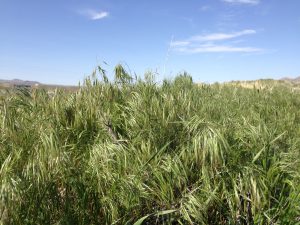 UM researchers, Cara Nelson, Ph.D. and Viktoria Wagner, Ph.D., along with two researchers from Canada, looked at government agencies and agricultural statistics companies in the U.S., Canada, and Mexico to find their data. The study found that the government agencies in Canada and Mexico kept no archived database of herbicide usage for invasive plant management. In the U.S., five out of seven agencies that were contacted by the researchers tracked herbicide usage, and only four of those agencies shared their data. These agencies include the Bureau of Indian Affairs, Bureau of Land Management, Fish and Wildlife Service, and National Park Service. The U.S. Forest Service, which oversees 193 million acres in the U.S., declined to share its data on herbicide use. The report found that even the agencies that did share their data did not consistently archive information on the effectiveness of the herbicide usage, the costs associated with usage, or make the information publicly available.
UM researchers, Cara Nelson, Ph.D. and Viktoria Wagner, Ph.D., along with two researchers from Canada, looked at government agencies and agricultural statistics companies in the U.S., Canada, and Mexico to find their data. The study found that the government agencies in Canada and Mexico kept no archived database of herbicide usage for invasive plant management. In the U.S., five out of seven agencies that were contacted by the researchers tracked herbicide usage, and only four of those agencies shared their data. These agencies include the Bureau of Indian Affairs, Bureau of Land Management, Fish and Wildlife Service, and National Park Service. The U.S. Forest Service, which oversees 193 million acres in the U.S., declined to share its data on herbicide use. The report found that even the agencies that did share their data did not consistently archive information on the effectiveness of the herbicide usage, the costs associated with usage, or make the information publicly available.
“We were surprised that we could not obtain a full accounting of herbicide usage for natural areas management in the U.S. and that no data were available for Canada,” Dr. Nelson said to the Missoulian. Dr. Nelson, who is a botanist and an associate professor in UM’s Department of Ecosystems and Conservation Science, stated to the Missoulian that herbicide use for managing invasive species can ”¦“also have substantial downsides, including the potential to further degrade ecosystems by reducing germination and establishment of native plants and facilitating secondary invasion by weeds,” she explained. “Although herbicides may kill target weeds, if native plants don’t establish after spraying, there is a high probability that undesirable plants will colonize and these so-called ”˜secondary invaders’ can have even more detrimental impacts than the plant that was the initial target for control. A common secondary invader in the west is cheatgrass (Bromus tectorum), which is one of the invaders that has the most severe effects on wildlife habitat and ecosystem function.”
The researchers found that in 2010, 1.2 million acres of U.S. federal and tribal wildlands were sprayed with 200 tons of herbicide. The most commonly used active ingredient was glyphosate, which is a nonselective herbicide that can also kill native grasses and herbs. The researchers point out that more oversight is needed to ensure taxpayer dollars are being used wisely and effectively. They concluded that it is essential to ensure ecological restoration practices have the intended effect, which would mean implementing a better system to monitor treatment outcomes.
The use of herbicides has been linked to shape changes in frogs and harm to non-target species, indicating that the risks are not worth the benefits. As with all pest problems, least-toxic alternatives provide a solution that addresses natural systems, and is more cost effective in the long term. A 2014 study shows that goats can adequately fill this need. Goats act as broad-spectrum weed killers; they will eat everything. In fact, goats are often more efficient at eradicating weeds, and are more environmentally sustainable than using harmful pesticides and chemicals. Once goats graze a weed, it cannot go to seed because it has no flower and cannot photosynthesize to take in sunlight and build a root system because it has no leaves. Grasses are a last choice for goats, which means desirable grass species are left behind with natural fertilizer to repopulate the land. Goats are notorious for eating poisonous plants, such as poison ivy and poison oak, and can handle them without getting sick.
Just recently, New York City’s Prospect Park decided to bring in a herd of goats to fight back against opportunistic species that are encroaching in an area of the park after damage caused by Hurricane Sandy. Rather than spray toxic weed killers like 2,4-D, triclopyr, or glyphosate, the Prospect Park Alliance used the grant money it obtained from the National Park Service to bring in these 4-legged weed warriors as a safe and environmentally friendly way to restore storm-damaged areas. Prospect Park joins the long and growing list of places that have opted for goat-powered weed control over the use of toxic pesticides. The list ranges from  Washington, DC’s Congressional Cemetery, to Google’s Corporate Campus, Chicago O’Hare International Airport, and cities from Durango, CO, to Carrboro, NC, and Cheyenne, WY. In California, they have been used to prevent wildfires during the drought.
Beyond Pesticides has long been an advocate for the use of goats and grazing animals as a least-toxic, biological solution for weed management. To learn more, read “Successfully Controlling Noxious Weeds with Goats: The natural choice that manages weeds and builds soil health.” Watch Beyond Pesticides’ Board Member Lani Malmberg, a professional goat herder and owner of Ewe4ic Ecological Services, speak at the 33rd National Pesticide Conference along with other experts on the Organic Land Management and Cutting Edge Alternatives panel. For more information on natural, non-chemical land management strategies see Beyond Pesticides’ Lawns and Landscapes and Invasive Weed Management pages.
Source: Journal of Applied Ecology, Missoulian
All unattributed positions and opinions in this piece are those of Beyond Pesticides.
Posted in Agriculture, Announcements, Invasive Species, Pesticide Drift, Pesticide Regulation, Pesticide Residues by: Beyond Pesticides
1 Comment
07
Jul
(Beyond Pesticides, July 7, 2016) Despite an outpouring of letters, calls and protests, in a key procedural vote yesterday, the Senate voted to deny Americans the right to know what is in in their food products, and to preempt states’ rights to create their own genetically engineered food labeling laws. In a cloture vote of 65-32, the highly-flawed genetically engineered (GE or GMO) labeling bill, S.B. 764, offered by Senators Debbie Stabenow (D-MI) and Pat Roberts (R-KY), also known as the Deny Americans the Right to Know (DARK) Act, passed through the Senate. This “compromise” bill allows producers to use QR codes and “smart labels” instead of clear, on-package labeling of food products that contain genetically modified organisms, which means that consumers will need to use a smart phone for the information. The bill also exempts major portions of current and future GE foods from being labeled, and, in an affront against democracy, preempts the genetically engineered food labeling laws in Vermont (which went into effect July 1), Connecticut, Maine and Alaska.
 “The American people have a right to know what they’re eating,” said Senator Bernie Sanders (I-VT), who vowed to put a hold on the bill if they didn’t reach the 60 votes needed for cloture during a press conference on Capitol Hill on Wednesday. “The timing of this legislation is not an accident. Its goal is to overturn and rescind the very significant legislation passed in the state of Vermont. I will do everything that I can to see that it’s defeated.”
“The American people have a right to know what they’re eating,” said Senator Bernie Sanders (I-VT), who vowed to put a hold on the bill if they didn’t reach the 60 votes needed for cloture during a press conference on Capitol Hill on Wednesday. “The timing of this legislation is not an accident. Its goal is to overturn and rescind the very significant legislation passed in the state of Vermont. I will do everything that I can to see that it’s defeated.”
Before the vote on Wednesday, food and consumer advocates dropped over $2,000 on the chamber floor as part of a symbolic protest against the act, highlight the financial ties between senators and biotechnology companies.  Additionally, polls and surveys  show overwhelming public support for labeling of genetically engineered foods, yet the same food and chemical companies continue to ignore consumers fight for the right to know every chance they get.
“It is deeply disturbing that a majority in the Senate would support a bill that openly discriminates against America’s low income, rural and elderly populations,” said  Andrew Kimbrell, Executive Director, Center for Food Safety. “This denies them their right to know simply because they are not able to afford or have access to smartphones. The bill itself is poorly drafted and would exempt many and perhaps most current genetically engineered foods from labeling. It was written behind closed doors between a handful of Senators and the big chemical and food companies. It is a non-labeling bill disguised as a labeling bill, a sham and a legislative embarrassment.”
The Senate bill includes no mandatory standards. Instead, it preempts Vermont’s law through a discretionary process that will be determined by a future Secretary of Agriculture. It also does very little to ensure consumers will actually have access to this information because the bill would allow for a range of labeling options that will not warn consumers —quick response (QR) codes, 800 numbers, websites and on-package labeling. This approach leaves poorer Americans at a disadvantage in receiving this information, as QR code labels require the use of a smartphone to read. Allowing food companies to decide how to label all but ensures they will work to misinform the public about their products; we have already seen big food links to websites that extol the safety of GE foods. The bill also contains a very weak definition the term “biotechnology” that may permit exemptions for a number of genetically engineered foods. There are no penalties for companies that do not comply with the conditions of the law.
An alternative approach to federal labeling, the Biotechnology Food Labeling and Uniformity Act (S.2621), led by Senators Jeff Merkley (OR), Patrick Leahy (D-VT), Jon Tester (D-MT), and Dianne Feinstein (D-CA) would have required that all consumer food packaging visibly display GE ingredient labeling. While ensuring nationwide labeling, the legislation would still preempt states from requiring labeling, such as a warning, which is stronger than the language in the legislation. Beyond Pesticides believes it is important that even a positive, mandatory labeling requirement not preempt states from setting a higher bar regarding information provided on GE ingredients in food.
In addition to concerns over the safety of eating GE food, there are direct and indirect effects of GE agriculture on the environment, wildlife, and human health. GE agriculture is associated with the increased use of herbicides —particularly glyphosate, the active ingredient in Roundup— that crops are developed to tolerate. In light of findings of the International Agency for Research on Cancer (IARC) that  glyphosate is a human carcinogen  based on laboratory animal test data, consumers have even more cause for concern about the health risks that these products pose.
The only way to truly avoid food produced with genetically engineered crops or processed with genetically engineered ingredients in the marketplace is to purchase foods that have the U.S. Department of Agriculture (USDA) certified organic seal. Under organic certification standards, genetically modified organisms and their byproducts are prohibited. Beyond Pesticides supports organic agriculture and is working to strengthen organic farming systems by encouraging biodiversity and holistic management practices, and upholding the spirit and values  on which the organic law was founded. Underpinning the success of organic in the U.S. are small-scale producers who focus on fostering biodiversity, limiting external inputs, improving soil health, sequestering carbon, and using integrated holistic approaches to managing pests, weeds, and disease. To learn more about organic agriculture, visit Beyond Pesticides’ Organic Agriculture, and Eating With a Conscious pages. For more information on GE foods and labeling issues, see Beyond Pesticides’  Genetic Engineering  website.
Source: Press Release, Common Dreams
All unattributed positions and opinions in this piece are those of Beyond Pesticides.
Posted in Alternatives/Organics, Announcements, Genetic Engineering, Labeling, National Politics, Pesticide Regulation by: Beyond Pesticides
No Comments
06
Jul
(Beyond Pesticides, July 6, 2016) Unable to come to a formal decision on glyphosate, the European Commission has issued a limited license extension for  glyphosate,  the pesticide in Monsanto’s flagship product Roundup. The decision also comes with some restrictions, including obligations for member states to minimize use on playgrounds, and a ban on formulations with the ingredient POEA. The  18-month interim license will allow glyphosate-containing products to remain on the market until the European Chemicals Agency rules  on glyphosate’s safety, an action  due by the end of 2017.
 According to the European Commission, “Despite repeated efforts from the Commission to address concerns expressed about the re-approval of glyphosate, Member States were not prepared to take responsibility for a decision  as no qualified majority was reached”¦” Debate has been raging in Europe about the continued use of glyphosate in light of the 2015 classification by the World Health Organization’s (WHO) International Agency for Research on Cancer (IARC) of glyphosate as a “probable human carcinogen.” However, confusion peaked when a few short months later the European Food Safety Authority (EFSA) published its report finding that glyphosate is  “unlikely to pose a carcinogenic hazard to humans.” However, EFSA’s report is  limited in that it reviewed glyphosate alone, unlike IARC which reviewed glyphosate and its formulated products (Roundup) which are more relevant for evaluating risks to human health.
According to the European Commission, “Despite repeated efforts from the Commission to address concerns expressed about the re-approval of glyphosate, Member States were not prepared to take responsibility for a decision  as no qualified majority was reached”¦” Debate has been raging in Europe about the continued use of glyphosate in light of the 2015 classification by the World Health Organization’s (WHO) International Agency for Research on Cancer (IARC) of glyphosate as a “probable human carcinogen.” However, confusion peaked when a few short months later the European Food Safety Authority (EFSA) published its report finding that glyphosate is  “unlikely to pose a carcinogenic hazard to humans.” However, EFSA’s report is  limited in that it reviewed glyphosate alone, unlike IARC which reviewed glyphosate and its formulated products (Roundup) which are more relevant for evaluating risks to human health.
Now the Commission waits on another agency, the European Chemicals Agency (ECHA) to conduct and complete another assessment of glyphosate, due in 2017. In the meantime, the Commission did offer some restrictions to the European use of glyphosate. These include a ban of the co-formulant polyethoxylated tallow amine or POEA from glyphosate-based products, obligations to reinforce scrutiny of pre-harvest uses of glyphosate, as well as to minimize use in specific areas like public parks and playgrounds. POEA, commonly used in glyphosate products and listed as an “inert” ingredient, has been shown to be even more toxic than glyphosate itself, and responsible for the elevated toxicity of glyphosate products.
Earlier this year, a European poll reported that the majority of people across the EU’s five biggest countries, including  three-quarters of Italians, 70% of Germans, 60% of French and 56% of Britons, support a ban on glyphosate. The herbicide is the  most widely used chemical in the world, according to reports, and as a result is being detected in food and  human bodies. Tests have detected  glyphosate residues in German beer, at levels higher than allowed in drinking water. Last year,  glyphosate residues were found in  bread  being sold in the UK. The  results of the  bread study  also shows that glyphosate use in the UK increased by 400% in the last 20 years and is one of the three pesticides regularly found in routine testing of British bread -appearing in up to 30% of samples tested by the UK government. A pilot study conducted by the group Moms Across America in 2014  found that glyphosate  may also bioaccumulate in the human body, as revealed by high levels of the chemical in the breast milk of mothers tested.
Glyphosate, created by Monsanto, is touted as a “low toxicity” chemical and “safer” than other chemicals by industry. But glyphosate has been shown to have  detrimental impacts  on humans and the environment. Given its widespread use on residential and agricultural sites, its toxicity is of increasing concern. In addition to IARC’s findings, previous studies  have linked the toxicant to non-Hodgkin’s lymphoma and multiple myeloma. It is also an endocrine disruptor, causes reproductive effects, kidney and liver damage, and is toxic to aquatic organisms, according to studies.  In September 2015, a study published in  Environmental Health News  found that  chronic, low-dose exposure to glyphosate  led to adverse effects on liver and kidney health. Roundup formulations can also induce a dose-dependent formation of DNA adducts (altered forms of DNA linked to chemical exposure, playing a key role in chemical carcinogenesis) in the kidneys and liver of mice. Human cell endocrine disruption on the androgen receptor, inhibition of transcriptional activities on estrogen receptors on HepG2, DNA damage and cytotoxic effects occurring at concentrations well below “acceptable” residues have all been observed.
In the U.S., the U.S. Environmental Protection Agency (EPA) has indicated it will release its preliminary risk assessment of glyphosate for public comment later this year. However, the agency found itself embroiled in some controversy after pulling its cancer risk assessment for glyphosate, which was noted as concluding that the chemical is not likely to be carcinogenic to humans.  After  pulling the report, the agency stated that the document was not final.
EPA also indicated that federal testing will  begin for glyphosate residues in food. However, although a positive step, this move is largely seen as political —a response to growing public pressure and not focused on evaluating health concerns. A  scientific review,  released in February 2016 by a group of 14  scientists, expressed concern about the widespread use of glyphosate-based herbicides, the lack of understanding regarding human exposure, and the potential health impacts. According to the report, U.S. agencies, such as the National Toxicology Program, the Centers for Disease Control and Prevention, and EPA, have not adequately kept up with cutting-edge research. The researchers call for the global science and regulatory community to step back and take a fresh look at glyphosate due to widespread exposure patterns.
Beyond Pesticides urges individuals concerned about glyphosate exposure to support organic systems that do not rely on hazardous carcinogenic pesticides. In agriculture, concerned consumers can  buy food with the certified organic label, which not only disallows synthetic pesticides like glyphosate, but also the use of sewage sludge and genetically engineered ingredients. Beyond Pesticides also urges the adoption of organic lawn and landscape programs.
All unattributed positions and opinions in this piece are those of Beyond Pesticides.
Source: European Commission Press Release
Posted in Agriculture, Announcements, Chemicals, Glyphosate, International, Pesticide Regulation by: Beyond Pesticides
1 Comment
05
Jul
(Beyond Pesticides, July 5, 2016) Last week, Malibu City Councilmembers, in a unanimous decision (5-0), voted to make Malibu, California’s (CA) public spaces poison free, which means an immediate ban on all pesticides, rodenticides and herbicides. During a marathon meeting that ran into the early hours past midnight, more than 24 Malibu residents and stakeholders came to give public comments on pesticide use on public parks and city property. You can view the city council meeting here. The entire discussion and vote is included, starting at 3:29:37 (or section 6.A.).
 Many of the residents were with an community  group called Poison Free Malibu, which is a group that advocates for the elimination of toxic pesticide use in the area. According to the Malibu Times, Kian Schulman, RN, founder of Poison Free Malibu, gave a presentation on the effects of pesticide chemicals and their connection to diseases such as cancer and neurological issues like ADHD and Alzheimer’s. Ms. Schulman’s presentation included a picture of a city worker spraying pesticides on Legacy Park, while wearing a full hazmat suit as a child rode their bicycle close by. Several Poison Free Malibu supporters attended the meeting and gave a presentation on the adverse effect of the chemicals and the failures of the Environmental Protection Agency to protect the public.
Many of the residents were with an community  group called Poison Free Malibu, which is a group that advocates for the elimination of toxic pesticide use in the area. According to the Malibu Times, Kian Schulman, RN, founder of Poison Free Malibu, gave a presentation on the effects of pesticide chemicals and their connection to diseases such as cancer and neurological issues like ADHD and Alzheimer’s. Ms. Schulman’s presentation included a picture of a city worker spraying pesticides on Legacy Park, while wearing a full hazmat suit as a child rode their bicycle close by. Several Poison Free Malibu supporters attended the meeting and gave a presentation on the adverse effect of the chemicals and the failures of the Environmental Protection Agency to protect the public.
The Malibu Monarch Project, a group dedicated to bringing the monarch butterfly population back to Malibu, also showed support for the pesticide removal. “Malibu should be the leader of environmental protection,” said Anya Jessup of the Malibu Monarch Project. Other non-affiliated residents expressed a desire for Malibu to lead the charge on environmental issues. “We say we’re environmentally conscious. Now we need to start acting like we’re environmentally conscious,” said local activist Jennifer deNicola, “Malibu needs to be this beacon of what cities can be.”
According to the Malibu Times, council members had met with Poison Free Malibu prior to the meeting, receiving additional information about the issues. All five members of the council showed support in their comments and provided potential additions on top of the suggested actions. “The City of Portland has a 60-page document of all the things they’ve looked at and tried. We ought to be doing that,” said Council Member John Sibert. He also cited the Environmental Sustainability Committee that was created in Malibu a year ago to specifically look at environmental sustainability policy.
Because of the state’s regressive pesticide preemption law, the city is barred from passing legislation that halts the use of pesticides on private property. However, Malibu joins dozens of communities across the country that have not let the issue of state preemption get in the way of passing policies that are still protective of human health and the environment, even if they are unable to restrict pesticide use on privately owned land. Concern over unnecessary cosmetic pesticide use has been echoed across the nation by grassroots coalitions of health and environmental advocates. In Montgomery County, Maryland, legislation introduced by Councilmember George Leventhal,  successfully  advanced  by the parent group Safe Grow Montgomery, allows only lawn care products to be used on private and public property that are compatible with organic practices. Maryland is one of only seven states that has not preempt local jurisdictions from  restricting pesticides more stringently than the state.
In 2012, Ohio’s Cuyahoga County Council voted to limit the use of chemical insecticides, weed killers and other pesticides on county property. That same year, Richmond, California’s City Council unanimously approved a pesticide reform ordinance targeting the use of toxic chemical pesticides within city boundaries. In February 2016, the  city council of St. Paul, MN adopted a resolution to make the city more pollinator friendly by banning bee-toxic neonicotinoids and other pesticides “proven  to be harmful to pollinators” and require an  updating of its  Integrated Pest Management (IPM) program,  mandating  non-chemical methods. That same month, the City Council of Irvine, CA, with a population of over 250,000 people, voted unanimously to stop the use of hazardous pesticides on city property. Just this month, Howard County, Maryland has taken the initiative to restrict the use of neonicotinoids on parklands.
Of 30 commonly used lawn pesticides, 17 are linked with cancer or carcinogenicity, 11 are linked with birth defects, 19 with reproductive effects, 24 with liver or kidney damage, 14 with neurotoxicity, and 18 with disruption of the endocrine (hormonal) system. Of those same 30 lawn pesticides, 17 are detected in groundwater, 23 have the ability to leach into drinking water sources, 24 are toxic to fish and other aquatic organisms vital to our ecosystem, 11 are toxic to bees, and 16 are toxic to birds. With numbers like this, the only logical question becomes: is this really necessary and what can we do to stop or prevent this kind of contamination?
For more information on organic-based, pesticide-free lawn and landscape management, see Beyond Pesticides’ Lawns and Landscapes program page. Beyond Pesticides encourages concerned citizens to stand up and make their voices heard in their community. If you’d like to join Malibu, CA and help ban pesticide use in your community’s public spaces, contact Beyond Pesticides at 202-543-5450 or at [email protected].
Source: Malibu Times
All unattributed positions and opinions in this piece are those of Beyond Pesticides.
Posted in Announcements, California, Lawns/Landscapes, National Politics, State/Local by: Beyond Pesticides
3 Comments
01
Jul
(Beyond Pesticides July 1, 2016) Lawmakers in France approved plans to totally ban neonicotinoid pesticides by 2018, based on their link  to declining populations of pollinators, specifically bees. This new restriction would go above and beyond current European Union (EU) restrictions on neonicotinoids, which limit the use of neonicotinoids, but do not ban them. The outright ban on neonicotinoid pesticides in France was adopted by a narrow majority of the  country’s  National Assembly, as part of a bill on biodiversity. While the bill must still gain the approval of the French Senate, which rejected it in a previous reading, passage by the Assembly is significant, as France becomes the first country to join state and local movements to eliminate the use of these toxic chemicals.
Neonicotinoids have been found by  a growing body of scientific literature  to be linked to honey bee and other pollinator declines. In light of these findings, in 2013 the European Commission  voted to suspend  the use of neonicotinoid pesticides for two years. The ban came several months a fter the European Food Safety Authority (EFSA)  released a report  identifying “high acute risk” to honey bees from uses of certain neonicotinoid chemicals.  Along with recent reports and studies highlighting the role these chemicals play in pollinator decline, there is evidence that the use of neonicotinoids are not efficacious or even necessary in agriculture. In August of 2015,  figures for the first oilseed rape harvest  since the European-wide ban was introduced show that the yield so far is higher than the average for the previous decade, when the chemicals were used on the majority of oilseed rape grown in the UK.  In 2014, the U.S. Environmental Protection Agency (EPA) released a  report  concluding that soybean  seed treatments with neonicotinoid insecticides provide little or no overall benefits in controlling insects or improving yield or quality in soybean production.  The seed treatment market has  more than tripled in size  between 1990 and 2005, with neonicotinoids making up 77 percent of the market share.
fter the European Food Safety Authority (EFSA)  released a report  identifying “high acute risk” to honey bees from uses of certain neonicotinoid chemicals.  Along with recent reports and studies highlighting the role these chemicals play in pollinator decline, there is evidence that the use of neonicotinoids are not efficacious or even necessary in agriculture. In August of 2015,  figures for the first oilseed rape harvest  since the European-wide ban was introduced show that the yield so far is higher than the average for the previous decade, when the chemicals were used on the majority of oilseed rape grown in the UK.  In 2014, the U.S. Environmental Protection Agency (EPA) released a  report  concluding that soybean  seed treatments with neonicotinoid insecticides provide little or no overall benefits in controlling insects or improving yield or quality in soybean production.  The seed treatment market has  more than tripled in size  between 1990 and 2005, with neonicotinoids making up 77 percent of the market share.
While France has established itself a leader in protecting pollinators, other European countries have not followed suit. The United Kingdom (UK) has raised opposition to EU efforts to limit the use of neonicotinoids at every turn. It  opposed the two year moratorium on neonicotinoid use, citing a study published in 2013 by Britain’s Food and Environment Research Agency (FERA), which found  “no clear consistent relationship” between exposure to neonicotinoids and the growth of bee colonies and the number of queens they produce. However, a  new analysis of the FERA data was conducted and it was concluded that the data clearly showed substantial negative effects of neonicotinoids on the performance of colonies. As a result, Britain was required  to comply with the ban under EU rules, though it did not stop FERA from approving an emergency application for the use of neonicotinoids in 2015. With UK’s recent decision to leave the EU, it is uncertain whether it  would continue the EU-wide restrictions currently in place on neonicotinoid pesticides.
France’s environment minister, Segolene Royal, is in favor of the proposed neonicotinoid ban, though he acknowledges that getting it past the Senate remains a significant obstacle. He is also  in favor of phasing out glyphosate, the main ingredient in Roundup. He said in a statement: “This decision will prepare us for the future and protect bees and the role they play. Research and development of substitute products has to accelerate.”
Earlier this month, a proposal for a temporary ”˜technical extension’ of the EU approval of the herbicide glyphosate failed to secure the support of a majority of EU governments at a meeting of the EU standing committee on plants, animals, food and feed, putting the chemical’s chance for re-approval up in the air. Glyphosate  has been subject to widespread public scrutiny since the International Agency for Research on Cancer (IARC) classified it as a  2A probable carcinogen  based on animal studies.
In the U.S., the struggle to address the pollinator crisis  continues to face obstacles, even in face of  a growing number of Americans  who believe bee declines are critical and linked to pesticide use.  Last week,  advocates delivered over four million signatures  to the EPA calling for decisive action on the rampant use of  neonicotinoids  and similar systemic insecticides, which scientists say are a driving factor in declining bee populations.  See more information on the serious decline of honey and other pollinators at www.beeprotective.org.
All unattributed positions are those of Beyond Pesticides
Source: Natural Society
Posted in Uncategorized by: Beyond Pesticides
No Comments
30
Jun
(Beyond Pesticides, June 30, 2016) In a move that goes one step further than the recently passed state-wide bill restricting consumer sales of neonicotinoid (neonics) products, Howard County, Maryland has taken the initiative to restrict the use of neonicotinoids on parklands. The new policy, announced June 16, cites the growing number of studies linking neonicotinoid use to adverse effects on pollinator species.
 The Department of Recreation and  Parks (DRP) manages approximately 10,000 acres of parkland within Howard County. According to the new policy and procedure, DRP is restricting the use of neonicotinoids, “due to recent research suggesting that there is a link between pesticides that contain neonicotinoids negatively effecting populations of pollinator species, such as; honeybees, native bees, butterflies, moths and other insects.” Neonics were often used on parklands for grubs on turf, Japanese beetles on trees,  and aphids on flowers and are now prohibited on all County parkland, including sports fields, garden plots, golf course and open space. Exemptions exist for agricultural uses and invasive pest infestations. Read the new neonicotinoid policy.
The Department of Recreation and  Parks (DRP) manages approximately 10,000 acres of parkland within Howard County. According to the new policy and procedure, DRP is restricting the use of neonicotinoids, “due to recent research suggesting that there is a link between pesticides that contain neonicotinoids negatively effecting populations of pollinator species, such as; honeybees, native bees, butterflies, moths and other insects.” Neonics were often used on parklands for grubs on turf, Japanese beetles on trees,  and aphids on flowers and are now prohibited on all County parkland, including sports fields, garden plots, golf course and open space. Exemptions exist for agricultural uses and invasive pest infestations. Read the new neonicotinoid policy.
Just this past May, Maryland officially became the first state in the nation to pass legislation  against neonicotinoids. The state legislature passed the  Maryland Pollinator Protection Act  (Senate Bill 198/House Bill 211), under which consumers will not be permitted to buy pesticides that contain neonicotinoids starting in 2018. Certified pesticide applicators, farmers and veterinarians will still be allowed to use neonicotinoids. Numerous studies  confirm that neonics contribute to bee mortality and colony health deterioration, as well as to declines in native pollinators, including birds and butterflies. At the national level, beekeepers lost an average of 44% of their colonies over the past year.  Last year, Maryland lost more than 60 percent of its beehives as commercial beekeepers – of which there are more than 1,800 statewide. These are losses are higher than the average reported national losses.
In an official statement, Howard County Executive Allan H. Kittleman said, “Many of us have heard about the decreasing numbers of both honey bees and monarch butterflies. While the EPA continues to look at the potential negative impacts of neonicotinoids, the Department of Recreation and Parks has crafted a policy that is practical and sets forth guidelines for those instances when there is no other option but to use neonicotinoids. We hope that this new policy will encourage the entire community to use alternative means to control pests.”
The policy incorporates feedback from the Recreation and Parks Board, the Howard County Bird Club, the Sierra Club and others. DRP began developing the policy after discussions between Mr. Kittleman and environmental advocates during fall 2015.
Other states like  Connecticut are also taking action to restrict the use of these harmful pesticides. Numerous  local communities,  universities, and  retailers  have also taken steps to remove neonicotinoid pesticides from use. At the federal level, Congress has an opportunity to suspend the use of  neonics  until they have been proven not to result in unreasonable adverse effects on pollinators through the  Saving America’s Pollinators Act. Last week, the White House released its  Pollinator Partnership Action Plan (PPAP),  a follow-up to its 2015  National Pollinator Health Strategy, which outlines action that can and are being taken to provide pollinators with more forage and habitat. However, the plan continued to fall short of meaningful action for pollinators, calling for very little protections from pesticides.
Beyond Pesticides and its allies have called for suspensions on neonicotinoid pesticides, particularly the most widely used and toxic: imidacloprid, clothianidin and thiamethoxam. These pesticides are used in a variety of home and garden products, and most commonly in corn and soybean seed coatings, where they remain in plant tissues, including pollen and nectar, for long periods of time. Along with suspensions of registrations, groups have urged EPA to conduct broader reviews on the impact of these systemic pesticides on ecosystems and organisms, including endangered species and biodiversity.
For more information of pesticides and pollinators visit, www.beeprotective.org.
All unattributed positions and opinions in this piece are those of Beyond Pesticides.
Posted in Announcements, Chemicals, Lawns/Landscapes, Maryland, neonicotinoids, State/Local by: Beyond Pesticides
No Comments
29
Jun
(Beyond Pesticides, June 29, 2016) A new report published by Regeneration Vermont finds that herbicide and chemical fertilizer use on Vermont dairy farms nearly doubled from 2002 to 2012, increasing from 1.54 to 3.01 pounds of herbicide per acre, respectively. The report, Vermont’s GMO Legacy: Pesticides, Polluted Water & Climate Destruction, by Will Allen, Ph.D. of Regeneration Vermont and Cedar Circle Farm, focuses on the failed promises of genetically engineered (GE, or GMO) crops to reduce chemical inputs required for crop production. While Vermont leads the nation on the GE labeling front, with its  law set to go into effect on July 1, the report, which highlights the flawed exemption on dairy and meat products, is a sobering reminder that this is only a part of the solution to the effects of GE crops and chemical-intensive agriculture.
“While the law will force mainstream food corporations to label GMOs in products like Cheetos and Spaghetti-os before coming into the state, it turns a blind eye to the GMO-derived dairy that is the primary ingredient in, for  example, Ben & Jerry’s ice cream and Cabot’s cheddar cheese,” says Dr. Allen. “This is about more than the consumer’s right to know. It’s also about the impact GMO-centered agriculture is having on Vermont’s environment and wildlife, its role in the continued monopolization of the food supply, and the roadblocks it creates in the path toward a truly regenerative, eco-sensitive, and socially-just form of agriculture in the state.”
example, Ben & Jerry’s ice cream and Cabot’s cheddar cheese,” says Dr. Allen. “This is about more than the consumer’s right to know. It’s also about the impact GMO-centered agriculture is having on Vermont’s environment and wildlife, its role in the continued monopolization of the food supply, and the roadblocks it creates in the path toward a truly regenerative, eco-sensitive, and socially-just form of agriculture in the state.”
At issue is the fact that the law specifically exempts dairy and meat products, though the state’s number one crop is feed corn, with over 92,000 acres of GE feed corn grown in Vermont. In fact, it finds that in a span of 13 years, there was a 12-fold increase in the adoption of GE corn in Vermont, from 8% of corn acreage planted with GE seed in 2002 to 90% in 2012.  The report finds that from 2002 to 2007, when GE production was at 47%, herbicide use averaged 160,201 pounds per year. From 2008-2012, when GE production was planted on 67-90% of corn acreage, herbicide use nearly doubled, with an average of 262,096 pounds per year.
Further, the report finds that eight highly toxic herbicides dominated pesticide use on Vermont corn crops, including atrazine, metholachlor, simazine, pendimethalin, glyphosate, acetochlor, dicamba,and alachlor. In light of findings of the International Agency for Research on Cancer (IARC) that  glyphosate is a human carcinogen  based on laboratory animal test data, consumers have even more cause for concern about the health risks that these products pose. Beyond Pesticides has long ascertained that consumers have a right to know whether the foods they buy contain GE ingredients, not only because of concerns over the safety of eating GE food, but also because of the direct and indirect effects of GE agriculture on the environment, wildlife, and human health. Furthermore, there are many environmental consequences of reliance on chemical-intensive, genetically engineered agriculture. Repeated spraying of these herbicides destroys refuge areas  for beneficial insects, such as the monarch butterfly, and  leads to resistance  in the very weed species that GE technology is intended to control. Yet, despite rampant glyphosate resistance and the presence of organic management practices that are  more protective of human health and the environment, the agrichemical industry continues to resort to increasingly toxic combinations of chemicals.
On the positive side, the report offers encouragement in the fact that more than 20% of Vermont’s dairies are organic, which is the highest percentage in the U.S. About 200 of the 970 Vermont dairy farms have adopted sophisticated organic rotational grazing systems, according to the report, which enhance the quality of the forage, and sequester large amounts of carbon that can help reverse climate change. Good organic practices work to build the soil and maintain an ecological balance that makes chemical fertilizers and synthetic pesticides unnecessary.
“Vermont is blessed with abundant water, lush pastures, and an environment where pastured cows can thrive,” concludes Will. “All of Vermont’s dairies could adopt a more sustainable form of dairy management, and the government and private businesses could help farmers make the transition and curb the pollution. We have the technical knowledge to make these management changes, but we urgently need to accelerate the transition to cleaner, safer, and more environmentally friendly dairy farming systems.”
Will Allen, Ph.D., is a longtime educator, activist and farmer dedicated to organic agricultural techniques that benefit the environment, farm workers and consumers. He was the founder of the Sustainable Cotton Project, a group that promoted organic growing practices and organic clothing, and the author of the seminal work on the history of toxic pesticides, The War on Bugs. Dr. Allen is currently the co-founder and co-manager, along with his wife, Kate Duesterberg, of Cedar Circle Farm in East Thetford, Vermont, a pioneering organic farm and education center. Will and his wife both spoke at the 34th National Pesticide Forum, Cultivating Community and Environmental Health, in Portland, Maine. You can hear about his personal experience on GE contamination and many of the issues brought forth in the report in the video of their talk, Regenerative Agriculture: Farming as if the Earth Matters.
The only way to truly avoid food produced with genetically engineered crops or processed with genetically engineered ingredients  in the marketplace is to purchase foods that have the U.S. Department of Agriculture (USDA) certified organic seal. Under organic certification standards, genetically modified organisms and their byproducts are prohibited. Beyond Pesticides supports organic agriculture and is working to strengthen organic farming systems by encouraging biodiversity and holistic management practices, and upholding the spirit and values  on which the organic law was founded. Underpinning the success of organic in the U.S. are small-scale producers who focus on fostering biodiversity, limiting external inputs, improving soil health, sequestering carbon, and using integrated holistic approaches to managing pests, weeds, and disease. To learn more about organic agriculture, visit Beyond Pesticides’ Organic Agriculture, and Eating With a Conscious pages. For more information on GE foods and labeling issues, see Beyond Pesticides’  Genetic Engineering  website.
Sources: VT Digger, Regeneration Vermont
All unattributed positions and opinions in this piece are those of Beyond Pesticides.
Posted in Uncategorized by: Beyond Pesticides
No Comments
28
Jun
(Beyond Pesticides, June 28, 2016) In an effort to block the impending implementation of Vermont’s genetically engineered (GE) food labeling law, Senators Debbie Stabenow (D-MO) and Pat Roberts (R-KS) have struck a deal aimed at continuing to keep consumers in the dark about the ingredients in the food they eat. Vermont’s law, signed on May 8, 2014 by Governor Peter Shumlin (D), is set to go into effect on July 1, 2016. After the state defeated a legal challenge brought by the Grocery Manufacturers of American and other industrial food companies, opponents pivoted their efforts to Congress, where they pushed for the so-called DARK (Denying Americans the Right to Know) Act, which would have codified a voluntary labeling system nationwide and preempted Vermont’s law. The DARK Act was passed through the House, yet failed to secure enough votes in the Senate.
Despite Senator Stabenow voting against the DARK Act earlier this year, she has now reached a DARK deal that, in effect, would continue to deny Americans important information about the presence of genetically engineered  ingredients in the food we eat. While proponents this DARK deal say it will require a mandatory national labeling scheme, the Senate bill includes no mandatory standards. Instead, it preempts Vermont’s law through a discretionary process that will be determined by a future Secretary of Agriculture. It also does very little to ensure consumers will actually have access to this information because the bill would allow for a range of labeling options that will not warn consumers – quick response (QR) codes, 800 numbers, websites and on-package labeling. This approach leaves poorer Americans at a disadvantage in receiving this information, as QR code labels require the use of a smartphone to read. Allowing food companies to decide how to label all but ensures they will work to misinform the public about their products; we have already seen big food links to websites that extol the safety of GE foods. The bill also contains a very weak definition the term “biotechnology” that may permit exemptions for a number of genetically engineered foods. There are no penalties for companies that do not comply with the conditions of the law. If passed, the bill would create a toothless, national charade and instantly extinguish forever the strong GE labeling laws passed overwhelmingly in recent years across New England.
ingredients in the food we eat. While proponents this DARK deal say it will require a mandatory national labeling scheme, the Senate bill includes no mandatory standards. Instead, it preempts Vermont’s law through a discretionary process that will be determined by a future Secretary of Agriculture. It also does very little to ensure consumers will actually have access to this information because the bill would allow for a range of labeling options that will not warn consumers – quick response (QR) codes, 800 numbers, websites and on-package labeling. This approach leaves poorer Americans at a disadvantage in receiving this information, as QR code labels require the use of a smartphone to read. Allowing food companies to decide how to label all but ensures they will work to misinform the public about their products; we have already seen big food links to websites that extol the safety of GE foods. The bill also contains a very weak definition the term “biotechnology” that may permit exemptions for a number of genetically engineered foods. There are no penalties for companies that do not comply with the conditions of the law. If passed, the bill would create a toothless, national charade and instantly extinguish forever the strong GE labeling laws passed overwhelmingly in recent years across New England.
Please let your Senators know you’re paying close attention to this issue, and demand the right to know what’s in your food!
Despite the illusion of compromise from members of the Senate, Vermont Senator and Democratic Presidential candidate Bernie Sanders has indicated he will make every effort to stop the DARK Deal from passing. “I am very proud that Vermont has led the country in GMO labeling,” he said in a statement published on his Senate website. “This bill would preempt what Vermont and other states have done. GMO labeling exists in dozens of countries around the world. It is not controversial. Already major food companies in our country have begun labeling their products. People have a right to know what is in the food they eat. I am going to do everything I can to defeat this legislation.”
An alternative approach to federal labeling, the Biotechnology Food Labeling and Uniformity Act (S.2621), led by Senators Jeff Merkley (OR), Patrick Leahy (D-VT), Jon Tester (D-MT), and Dianne Feinstein (D-CA) requires that all consumer food packaging visibly display GE ingredient labeling. While ensuring nationwide labeling, the legislation would preempt states from requiring labeling, such as a warning, which is stronger than the language in the legislation. Beyond Pesticides beleives it is important that even a positive, mandatory labeling requirement not preempt states from setting a higher bar regarding information provided on GE ingredients in food.
Beyond Pesticides believes that consumers have a right to know whether the foods they buy contain GE ingredients, not only because of concerns over the safety of eating GE food, but also because of the direct and indirect effects of GE agriculture on the environment, wildlife, and human health. GE agriculture is associated with the increased use of herbicides —particularly glyphosate, the active ingredient in Roundup— that crops are developed to tolerate. In light of findings of the International Agency for Research on Cancer (IARC) that  glyphosate is a human carcinogen  based on laboratory animal test data, consumers have even more cause for concern about the health risks that these products pose. See Beyond pesticides Genetic Engineering program page for more information on GE agriculture and alternatives to this toxic system of food production.
The Senate is expected to vote on the legislation before July 1st.
Help us stop this DARK deal from getting the 60 vote majority it needs by sending a letter to your Senators today!
All unattributed positions and opinions in this piece are those of Beyond Pesticides.
Source: Press Release: Senate Committee on Agriculture, Nutrition, and Forestry, Press Release: Senator Bernie Sanders
Posted in Uncategorized by: Beyond Pesticides
1 Comment
27
Jun
(Beyond Pesticides, June 27, 2016) A new report released last  week by the Organic Seed Alliance (OSA) found that the supply of organic seeds is not keeping up with the rising demand for organic products. The organic sector grew 11 percent between 2014 and 2015, with sales last year totaling $43 billion. The United States Department of Agriculture (USDA)’s National Organic Program (NOP) does require the use of organic seed when commercially available, but because the organic seed sector was almost nonexistent when the program began, it is still working to meet demand. In cases where organic seeds are not commercial available, organic farmers are allowed to turn to conventional seed alternatives.
 According to OSA’s State of Organic Seed report, funded by the Clif Bar Family Foundation’s Seed Matters Initiative, the UNFI Foundation, and New Belgium Brewing Company, the biggest organic operations actually use a relatively small amount of organic seed. They found that vegetable farmers that grow on less than ten acres use, on average, 75 percent organic seed, while growers that farm over 480 acres use only 20 percent organic seed. The authors of the report surveyed 1,365 organic farms, 16 seed companies, 46 researchers and 22 accredited organic certifying agencies. OSA did find an increase in the number of farms using 100 percent organic seed (from 20 percent to 27 percent), and across all crop types, more than 30 percent of farmers use more organic seed presently than they did three years ago.
According to OSA’s State of Organic Seed report, funded by the Clif Bar Family Foundation’s Seed Matters Initiative, the UNFI Foundation, and New Belgium Brewing Company, the biggest organic operations actually use a relatively small amount of organic seed. They found that vegetable farmers that grow on less than ten acres use, on average, 75 percent organic seed, while growers that farm over 480 acres use only 20 percent organic seed. The authors of the report surveyed 1,365 organic farms, 16 seed companies, 46 researchers and 22 accredited organic certifying agencies. OSA did find an increase in the number of farms using 100 percent organic seed (from 20 percent to 27 percent), and across all crop types, more than 30 percent of farmers use more organic seed presently than they did three years ago.
The report outlines some challenges preventing greater adoption of organic seed, such as the price of organic seeds over conventional. Conventional seed is cheaper to produce and buy, according to data from 473 vegetable varieties from 21 companies, provided by the seed-buying search engine Pick A Carrot. Organic seed costs, on average, 65 percent more than conventional. While price is not an allowable reason for not sourcing organic seed under organic standards, this remains as an obstacle for organic farmers.
Then, there is the issue of coexistence between farmers using genetically engineered (GE) crops and non-GE farmers. Some organic farmers struggle with maintaining organic seed purity due to contamination. GE crops pose a constant threat to the livelihood of organic farmers and undermine the burgeoning growth of the organic industry. A 2014 study released by Food and Water Watch and the Organic Farmers’ Agency for Relationship and Marketing (OFARM), in response to USDA’s Advisory Committee on Biotechnology and 21st Century Agriculture (AC21) report in 2012, found that one-third of organic farmers have experienced GE contamination on their farm due to the nearby use of GE crops . Over half of these growers have had loads of grain rejected because of unwitting GE contamination. These rejections can lead to big income losses for farmers, with a median cost of approximately $4,500 per year per farmer, according to the survey. Additionally,  several farmers report annual losses of over $20,000 due to the need to establish buffer zones, limiting the threat of contamination from their neighbors by taking contiguous farmland out of production.
Beyond Pesticides believes that shifting the responsibility of contamination away from small-scale and organic farmers to the GE patent holder and GE farmers  —a polluter pays principle—  is an important first step in leveling the playing field and achieving the desired level of coexistence between growing operations. A system in which organic farmers are forced to expend resources to protect themselves from the choices of others, while potential trespassers are merely allowed to go about their business regardless of consequences is not equitable coexistence and is not a permanent solution.
OSA released some top recommendations on how to move the organic seed sector forward, and to serve as a road map for organic seed stakeholders over the next five years:
- Invest more public and private dollars in organic seed research. Organic plant breeding and other organic seed research must be a funding priority in agricultural research grants, including government programs and private and non-private foundations.
- Train more organic farmers in seed production. Organic farmers who produce seed, or want to produce seed, need more training, resources, and research to support their success.
- Advocate for organic seed. Educating and working with organic certifiers and NOP to support consistent enforcement of the organic seed requirement. Priorities also include addressing risks to organic seed integrity and innovation, including genetically engineered crops and restrictive intellectual property rights.
Beyond Pesticides supports organic agriculture as effecting good land stewardship, and is working to strengthen organic farming systems by encouraging biodiversity and holistic management practices, and upholding the spirit and values  on which the organic law was founded. It is impossible to discuss the ecological and economic benefits of organic agriculture without discussing the devastating effects of conventional agriculture. Good organic practices work to build the soil and maintain an ecological balance that makes chemical fertilizers and synthetic pesticides unnecessary.
Underpinning the success of organic in the U.S. are small-scale producers who focus on fostering biodiversity, limiting external inputs, improving soil health, sequestering carbon, and using integrated holistic approaches to managing pests, weeds, and disease. Organic agriculture has been proven time again to be equally viable for both farmers and consumers while also providing significant health and environmental effects over conventional industrial agriculture.
All unattributed positions and opinions in this piece are those of Beyond Pesticides.
Source: Civil Eats, State of Organic Seed, 2016
Posted in Agriculture, Alternatives/Organics, Announcements, National Politics by: Beyond Pesticides
No Comments
24
Jun
(Beyond Pesticides, June 24, 2016) The U.S. Department of Agriculture (USDA), during its Pollinator Week Festival at the “People’s Garden” on Friday, has shut out environmental public interest groups that are advocating pesticide restrictions to protect bees. Instead, the agriculture agency is teaming up with other federal agencies and chemical industry groups that advocates say have been tone deaf to beekeepers’ pleas for federal government action. This new controversy emerges in the midst of an escalating pollinator crisis with 44% bee colony losses in the last year.
Advocates, who bring the voice of independent science and point to the dangers of bee-toxic neonicotinoid insecticides as a major contributor to the decline in pollinator populations, have been disinvited to the event. 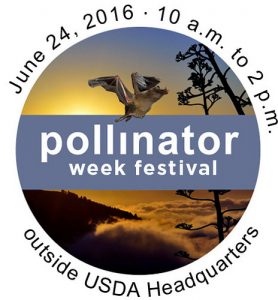 Meanwhile, the Pollinator Partnership, an organization closely affiliated with the chemical industry (Bayer, Syngenta, BASF, CropLife, have all been previously listed as sponsors) will be in attendance. Groups like Beyond Pesticides, which bridges environmental, consumer and farm interests, have participated for several years in the Festival.
Meanwhile, the Pollinator Partnership, an organization closely affiliated with the chemical industry (Bayer, Syngenta, BASF, CropLife, have all been previously listed as sponsors) will be in attendance. Groups like Beyond Pesticides, which bridges environmental, consumer and farm interests, have participated for several years in the Festival.
“The foundation for a constructive dialogue between federal agencies and the public regarding the decline of our critical pollinator populations rests upon the free exchange of information and viewpoints,” said Jay Feldman, executive director of Beyond Pesticides. “We are disappointed that USDA has decided to rescind the offer to participate in the Pollinator Week Festival.”
Last month, the U.S. Government Accountability Office (GAO) reported that USDA and the U.S. Environmental Protection Agency (EPA) are falling short in their efforts to protect honey bees and other wild pollinators from catastrophic declines. According to the report, USDA has not begun to coordinate with other agencies to develop a plan for monitoring wild, native bees because they were focused on other priorities, although charged to do so by the White House Pollinator Task Force. USDA was also chastised by GAO for its inability to evaluate its conservation programs. Although the agency has dedicated millions of dollars to conservation programs, USDA does not have the internal expertise to evaluate the effectiveness of its methods, according to GAO.
Last spring, the White House released its much awaited plan for protecting American pollinators, which identifies key threats, but falls short of recommendations submitted by Beyond Pesticides, beekeepers, and others who stress that pollinator protection begins with strong regulatory action and suspension of bee-toxic pesticides. The Pollinator Health Task Force, established by President Obama in June 2014, brought together most federal agencies to “reverse pollinator losses and help restore populations to healthy levels,” and involved developing a National Pollinator Health Strategy and a Pollinator Research Action Plan. On Wednesday, the White House released its Pollinator Partnership Action Plan (PPAP), which is being criticized as falling short of meaningful action for pollinators, calling for very little protections from pesticides.
Beyond Pesticides and its allies have called for suspensions on neonicotinoid pesticides, particularly the most widely used and toxic: imidacloprid, clothianidin and thiamethoxam. These pesticides are used in a variety of home and garden products, and most commonly in corn and soybean seed coatings, where they remain in plant tissues, including pollen and nectar, for long periods of time. Along with suspensions of registrations, groups have urged EPA to conduct broader reviews on the impact of these systemic pesticides on ecosystems and organisms, including endangered species and biodiversity. Just yesterday, environmental advocates and beekeepers delivered over 4 million signatures to EPA urging an immediate ban on bee-killing pesticides.
All unattributed positions and opinions in this piece are those of Beyond Pesticides.
Posted in Agriculture, Alternatives/Organics, Announcements, National Politics, State/Local, Take Action, Washington D.C. by: Beyond Pesticides
1 Comment
23
Jun
(Beyond Pesticides, June 23, 2016) A truck full of dead bees made its final stop yesterday at a rally outside the headquarters of the U.S. Environmental Protection Agency (EPA), culminating a coast-to-coast tour to raise awareness about recent massive declines in pollinators. While the millions of dead bees stayed on the truck, advocates and beekeepers, including Beyond Pesticides, delivered over 4 million signatures urging an immediate ban on bee-killing pesticides.
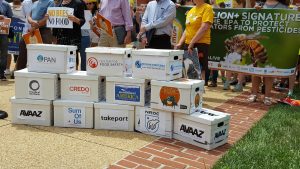

“In the five years since I started keeping bees, I’ve seen many hives killed by pesticides,” said James Cook, a Minnesota-based beekeeper who has been driving the truck across the country since last Monday. “If some fundamental things don’t change, it’s going to be really hard for beekeepers to adapt to the environment around us.”
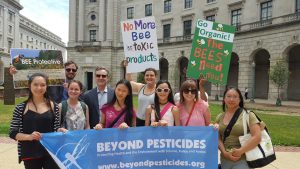
Beyond Pesticides staff and friends, including Scott Nash from Moms Organic Market
Bees pollinate most of the world’s most common crops, including summer favorites like peaches and watermelon. But over 40 percent of U.S. honeybee hives die each year, costing the farming and beekeeping industry more than $2 billion annually.
The most significant culprit in the bee die-off is the widely-used class of pesticides called neonicotinoids, or neonics. Last spring EPA began a process to assess four types of neonics and their impacts on pollinators. In January the Agency acknowledged that imidacloprid does indeed harm bees, but the remaining assessments are still outstanding.
“Bees are the most important thing for sustainable food growth, which is one of the reasons I have always sourced 100 percent organic food, free of pesticides that may cause pollinators harm,” said Nora Pouillon, owner and founder of Restaurant Nora, America’s first certified organic restaurant.
“What’s happening today to pollinators is no different than what happened 50 years ago with the collapse of the osprey, bald eagle, and other bird and aquatic animal populations due to the use of DDT,” said Scott Nash, CEO of Mom’s Organic Market. “If we allow the chemical agribusiness industry to continue these short-sighted practices, food costs will increase as food supplies diminish.”
To wrap up their Keep the Hives Alive Tour, farmers, beekeepers and food advocates will meet with officials from EPA, members of Congress, and representatives from the U.S. Department of Agriculture, delivering letters from nearly 200 businesses and organizations urging action on bee-killing pesticides and support for sustainable agriculture.
“The science is clear and convincing. To be truly effective, we need a nationwide policy to protect our pollinators before the crisis gets completely out of control,” said Del. Anne Healey, sponsor of Maryland’s Pollinator Protection Act, the first bill passed in the United States to eliminate consumer use of neonics.
Over the past two weeks Keep the Hives Alive has made stops in California, South Dakota, Minnesota, Michigan, Pennsylvania, and North Carolina. It comes to a close during National Pollinator Week, at a rally where environmental advocates, farmers, restaurant owners and others joined beekeepers to call for action.
“I have never seen any compelling reason to use systemic insecticides,” said Jim Goodman, farmer and owner of Northwood Organic Farm in Wonewoc, Wisconsin. “Crop rotation as part of a diverse mix of crops, pasture and native plants  seems to work quite well. Of course it makes little profit for the corporations that manufacture agricultural chemicals — and there is the rub.”
“We have so many losses it’s worse than break-even. It is getting harder and harder to keep bees and make a living,” said Roger Williams, president of the Central Maryland Beekeepers Association. “And if we stop keeping bees, who’s going to pollinate your fruits and vegetables? This can’t go on.”
Additional Action for Pollinator Week
Made by Pollinators Campaign. All week long, select restaurants in the DC-area will celebrate pollinator week by identifying ingredients that are pollinator dependent and showcasing the importance of pollinators to our food system. These restaurants also support local, organic and sustainable practices that take into account whole food and ecological systems. Given that every one in three bites of food is reliant on pollination, the campaign will educate the public on the importance of pollinators and ways to become more involved in protecting bees and other pollinators. For more information, visit www.beeprotective.org.
Participating restaurants include:
- Busboys and Poets
1025 5th St NW (and at other select locations)
- Founding Farmers
1924 Pennsylvania Ave NW, Washington, DC 20006 (and at other select locations)
- Lavagna
539 8th St SE, Washington, DC 20003
- Tabard Inn
1739 N St NW, Washington, DC 20036
- Restaurant Nora
2132 Florida Ave NW, Washington, DC 20008
Organize a Meeting in Your Community. Utilize a public space, such as your local library or community center, have a house party, or host a pollinator-friendly dinner and view the talk Pollinators, Biodiversity and Scientific Integrity, by Jonathan Lundgren, Ph.D. from Beyond Pesticides’ 34th National Pesticide Forum. This is a perfect opportunity to have a discussion with your friends and neighbors about the serious issue of pollinator decline and what you can do.
Support pollinator friendly legislation. Ask your U.S. representative to support the re-introduced  Saving America’s Pollinator Act  (SAPA). This is a bill that would suspend the use of neonicotinoid pesticides until a full review of scientific evidence and a field study demonstrates no harmful impacts to pollinators.  Contact your Representative now.
Support retailers that are providing safer alternatives. Local ACE franchises are already proving that hardware stores don’t need to sell neonics or any other toxic pesticides in order to be financially successful. Eldredge Lumber and Hardware and Kittery ACE of York, Maine are  consciously stocking their shelves with organic compatible products, and providing seeds and nursery plants that are not treated by bee-toxic chemicals. Visit your local hardware or garden retailer and ask them to also to stop selling neonicotinoids and other bee-toxic pesticides, and source more organic alternatives, or give them a call today! You can also find your own source of organic seeds and plant starts by going to Beyond Pesticides’  Pollinator Friendly Seed and Nursery Directory.
Tell EPA to do more for pollinators. EPA has acknowledged that pesticides are a problem, but little meaningful action has been done to reverse pollinator declines. Bees need real protections from toxic pesticides now. It’s time for EPA to get serious about protecting bees by suspending neonicotinoids.
Make Change Happen in Your Community. Â Armed with allies and resources from your video screening party, go to your elected official and ask them to introduce the Model Pollinator Resolution and/or our Model Lawns and Landscapes policy.
—Get the  Model Community Pollinator Resolution  here, and our  Model Lawns and Landscapes Policy  here.
—For more information, see our  BEE Protective webpage, or  get in touch with us.
For more information on what you can do to protect pollinators, see  www.beeprotective.org.
All unattributed positions and opinions in this piece are those of Beyond Pesticides.
Posted in Announcements, Habitat Protection, Increased Vulnerability to Diseases from Chemical Exposure, National Politics, Pesticide Regulation, Pollinators, State/Local, Take Action, Washington D.C., Wildlife/Endangered Sp. by: Beyond Pesticides
No Comments
22
Jun
(Beyond Pesticides, June 22, 2016) In a ruling that organic advocates say is critical to the integrity of the USDA organic label, a U.S. District Court judge found Monday that the U.S. Department of Agriculture (USDA) violated public process when it decreed that pesticide-contaminated compost is allowed in organic production. Three groups that bridge environmental, consumer, and farmer interests sued USDA for ruling that green waste compost, which comes from lawn clippings and plants, may contain levels of the insecticide bifenthrin and other pesticides that have not been approved for use in organic systems through proper public hearing and comment procedures. The case focused principally on whether USDA, in failing to conduct a formal public review, was operating “at its whim.” The court found that is exactly what USDA did and ordered the agency to stop allowing the use of contaminated compost by August 22, 2016.
 U.S. District Judge Jacqueline Scott Corley of the Northern District of California found that USDA’s National Organic Program (NOP) operated without the required notice and comment. She explained, “the reach of the Agency’s  new rule stretches beyond bifenthrin and instead allows green waste or green waste compost used in organic production to contain any synthetic pesticide of which bifenthrin is just one example.” The plaintiffs in the case are Center for Environmental Health (CEH), Center for Food Safety (CFS), and Beyond Pesticides. See Press Release
U.S. District Judge Jacqueline Scott Corley of the Northern District of California found that USDA’s National Organic Program (NOP) operated without the required notice and comment. She explained, “the reach of the Agency’s  new rule stretches beyond bifenthrin and instead allows green waste or green waste compost used in organic production to contain any synthetic pesticide of which bifenthrin is just one example.” The plaintiffs in the case are Center for Environmental Health (CEH), Center for Food Safety (CFS), and Beyond Pesticides. See Press Release
“The court decision upholds an organic industry that has been built on a foundation of consumer and farmer investment in ecologically sound practices, principles, and values to protect health and the environment,” said Jay Feldman, executive director of Beyond Pesticides. “USDA has violated a basic requirement of public accountability in the standard setting process, which is fundamental to public trust in the organic label and continued growth of the organic sector,” he added.
“The decision is a vital victory for organic integrity, on behalf of organic consumers, organic farmers, and the environment,” said senior CFS attorney George Kimbrell, counsel for the plaintiffs.
In 2009, the California Department of Food and Agriculture (CDFA) found compost contaminated with the insecticide bifenthrin and stopped the use of three compost products. Bifenthrin, a synthetic pyrethroid, is a possible cancer causing agent, endocrine disruptor, and neurotoxic chemical. After the UDSA contamination allowance in 2010, the California prohibition was lifted.
The Organic Trade Association, California Certified Organic Farmers (CCOF) [a certifying agency], and Western Growers Association intervened in the case, claiming that a decision that vacates the contamination rule would cause “profound disruptions to the organic industry” and require an “astronomical. . .testing regime.” The judge responded with, “Amici’s testing argument makes no sense.”
As the Judge points out, testing previous to the USDA allowance had been done “when there is reason to believe that the agricultural input or product has come into contact with a prohibited substance or has been produced using excluded methods.” Testing performed by the Washington State Department of Agriculture (which tests for pesticide contamination to comply with Canadian organic certification) found that of the 13 tested composts, five had pesticide residues, according to court records. The Judge cited testimony that other compost was found during the prohibition of contaminated compost in California and the contamination is avoidable.
Advocates argue that when registering pesticides like bifenthrin, the U.S. Environmental Protection Agency (EPA) must be required to protect against contamination of the green waste stream because of pesticides’ adverse environmental and public health effects, as well as the adverse economic impact that contamination may have on the now $40 billion organic industry.
“We applaud the court’s decision to protect the integrity of the  organic program,” said Caroline Cox, Research Director of CEH. “We will continue to watchdog the USDA to insure that the program meets consumers’ expectations for meaningful organic standards.”
Background
Before the challenged decision, organic producers were prohibited from using compost contaminated with pesticides or other synthetic substances not allowed in organic farming. National Organic Program (NOP) regulations specifically prohibit use of “[a]ny fertilizer or composted plant and animal material that contains a synthetic substance not included on the National List of synthetic substances allowed for use in organic crop production.” 7 C.F.R. § 205.203(e)(1). However, after California organic regulators, acting with the then-approval of NOP, banned several pesticide-contaminated composts, the producer of that compost, along with other members of the waste management, composting, and large organic industry, insisted that the rule be changed. After consultation with members of these industries, but without public participation, USDA ultimately issued the new decision, allowing the use of greenwaste (e.g. like lawn clippings) compost contaminated with prohibited substances, such as the residential pesticide bifenthrin.
In 2009, NOP circulated internally a first “draft policy for pesticide residues in compost,” and proposed applying the EPA food tolerance standards to compost – the lowest allowable residue level of that pesticide in food. However, NOP rejected this approach citing it would be “too difficult and too time consuming” to set tolerance levels and obtain the scientific justification for them. NOP then adopted the new ruling which provides “no tolerance levels for pesticide contaminants in compost.”
The plaintiffs allege that the USDA’s decision weakens the integrity of organic food production, not only by creating inconsistent organic production standards but also by undermining the essential public participation function of organic policy making under the Administrative Procedure Act (APA), federal law that establishes the  procedures for public input into federal policy making. Since USDA never subjected the contaminated-compost decision to formal notice and public comment, the plaintiffs argue that USDA failed in its duty to ensure that its regulation is consistent with the Organic Food Production Act (OFPA) and the standards set forth for approving the use of synthetic substances.
In arguments, defendants contend that the organic industry will likewise suffer significantly if NOP compost action is vacated because organic growers will no longer be able to use green waste compost and composting operations will lose a significant market for their products. However, the court found is insufficient evidence in the record to support their assertion or quantify it.
After the plaintiff organizations initiated the litigation in 2015 challenging USDA’s issuance of the guidance without giving the public and organic stakeholders the opportunity to participate and object, USDA moved to dismiss the case, arguing that it could unilaterally open the new loophole through a guidance document.  Last fall the Court denied that motion and the case proceeded.  Earlier this spring, over a year after the case was filed, several industry groups (including a group with ties to pesticide giants, the certifier group CCOF, and the organic industry lobbying entity, the Organic Trade Association) showed up to argue that the Court should leave USDA’s loophole in place even if it found the agency violated the law in establishing it.
In light of the new ruling, should USDA try to change the law again, it will have to do so with public participation, ensuring that the public can continue to watchdog the integrity of organic.
The organic program has a long history of providing  numerous opportunities for the public to weigh in on allowable practices and materials in organic production and has been central to building public trust in the organic certification program and the USDA certified organic food label. The National Organic Standards Board (NOSB) was set up by Congress to serve as an independent authority with unique and sole powers over organic standards. The board is intended  to safeguard the integrity of the organic food label with independent authorities that operate outside the discretion of the USDA. The proposals of the NOSB, as a part of its ongoing review of practices and materials, are  published for public comment twice a year before each meeting of the board.
For more on organic standards and how you can play a part in maintaining the integrity of organic, visit the  Keeping Organic Strong webpage  and Save Our Organic webpage.
All unattributed positions and opinions in this piece are those of Beyond Pesticides.
Posted in Agriculture, Alternatives/Organics, Announcements, Litigation, National Politics, Pesticide Residues by: Beyond Pesticides
2 Comments
21
Jun
(Beyond Pesticides, June 21, 2016) New regulations issued by the European Commission (EU) last week to regulate endocrine disruptors in pesticide products are being criticized by public interest groups and scientists as undermining the precautionary legal standard governing pesticide use in Europe. Previous  investigations and reports  have uncovered  industry’s attempt to quash efforts to enact robust protections from these harmful chemicals, despite their likely contribution to billions of dollars in lost revenue due to health effects.
 EC’s new rules endorse the World Health Organization’s definition of endocrine disrupting chemicals (EDC). The WHO defines an endocrine disruptor as “an exogenous substance or mixture that alters function(s) of the endocrine system and consequently causes adverse health effects in an intact organism, or its progeny, or (sub)populations,” However, the proposed regulations go little beyond defining the term. “The WHO definition is not a criteria, it is just a definition,” said Andreas Kortenkamp, PhD to The Guardian. “In effect, the commission has decided to place the burden of deciding how to regulate endocrine-disrupting chemicals onto the assessors on a case-by-case basis.”
EC’s new rules endorse the World Health Organization’s definition of endocrine disrupting chemicals (EDC). The WHO defines an endocrine disruptor as “an exogenous substance or mixture that alters function(s) of the endocrine system and consequently causes adverse health effects in an intact organism, or its progeny, or (sub)populations,” However, the proposed regulations go little beyond defining the term. “The WHO definition is not a criteria, it is just a definition,” said Andreas Kortenkamp, PhD to The Guardian. “In effect, the commission has decided to place the burden of deciding how to regulate endocrine-disrupting chemicals onto the assessors on a case-by-case basis.”
Of concern is the level to which the rules reflect a hazard or risk-based criteria. While EC asserts that its rules will follow the law’s charge to implement hazard-based criteria, which addresses the inherent risk associated with exposure to a chemical, the new proposal will permit exemptions when risk of exposure is negligible. This would appear to provide a major loophole to the original intent of the law, as it is suggested that the exemption be evaluated in the form of a risk assessment. “It is a total reversal of the intention of the regulation,” Dr. Kortenberg said to The Guardian, “the worst of all the possible outcomes. Risk assessments are precisely what industry has lobbied for, and the commission has given it to them.”
Per Pesticide Action Network Europe’s report, Impact Assessment of the Criteria for Endocrine Disrupting Pesticides, the EC proposal follows what is known as option 2, which would lead to banning only a few pesticides. However, PAN-Europe notes that because of the potential for derogations (exemptions) based on risk of exposure, the proposal “will effectively result in no single endocrine disrupting chemical being banned.”
“There cannot be any other conclusion but that Commission lets the interests of trade and industry prevail over the interests of the public and fails to reduce the millions of health costs and the suffering of people in Europe due to endocrine related diseases,” said PAN-Europe in a press release. Studies prepared for the EC by international teams of scientists and researchers determined that the health care costs imposed by public exposure to endocrine disrupting chemicals resulted in over € 150 billion ($162 billion) in health care costs to the European Union each year. The most significant economic drain was attributed to loss of brain function for the next generation, with an estimated 13 million IQ points lost due to prenatal exposure to organophosphate pesticides. A subsequent study focused on the health care costs of female reproductive disorders in the EU also found costs to be substantial. Attributable cases of DDE-induced fibroids were estimated to be 56,700 and phthalate-induced endometriosis at 145,000.  This was calculated to result in €163 million ($183 million) and €1.25 billion ($1.4 billion) in health care costs, respectively.
“Sadly, today’s package seems to confirm our concerns that the commission has lowered its ambition concerning strong EDC criteria so as not to jeopardise the TTIP [Transatlantic Trade and investment Partnership] talks with the U.S.,” said Sylbia Maurer of the Europe-based consumer group BEUC to The Guardian. Last year, several reports of US-based intervention on behalf of the international agrichemical industry surfaced as negotiations on TTIP wore on. Despite TTIP effectively stalled in the US without support from either major party Presidential candidate, European environmental and consumer groups charge that industry has won the concessions it sought.
If no derogations apply, the pesticides mancozeb, maneb, metconazole, propyzamide, thiophanate-methyl, and tralkoxydim are likely to be banned. In late April, the EU banned its first pesticides as a result of their endocrine disrupting properties.
While the EC Â begins a process to regulate endocrine disruptors, the U.S. has taken little action despite a mandate from the 1996 Food Quality Protection Act (FQPA) that requires EPA to screen pesticides for their endocrine disrupting potential. Thus far, the agency has only partially screened some chemicals.
Under EPA’s endocrine disruption screening protocol (EDSP), the agency uses a two-tiered approach  to screen pesticide chemicals and environmental contaminants for their potential effect on estrogen, androgen and thyroid hormone systems. EPA’s last publicly released report for tier 1 screening of only 52 chemicals found  no evidence of endocrine pathways for 20 chemicals. For 14 chemicals that the agency said did show potential interaction, EPA stated that it “already has enough information to conclude that they do not pose risks.” Of the remaining 18 chemicals, EPA found that all showed potential interaction with the thyroid pathway, 17 of them with the androgen (male hormones) pathway, and 14 also potentially interacted with the estrogen (female hormones) pathway.
It will take several more years for EPA to completely screen any endocrine disrupting chemicals. Not surprisingly,  EPA’s EDSP has been heavily criticized for decades-long delays and not putting the chemicals through more rigorous testing that includes low dose responses in the interest of protecting human health and the environment. The agency does not evaluate the potential for chemicals to exhibit non-monotonic dose response curves, where a material shows the potential for a harmful response at low, even minute levels of exposure. This effect, confirmed through independent research, challenges the traditional toxicological maxim that “the dose makes the poison.”  The failure to incorporate modern toxicological science has led researchers to criticize EPA’s testing protocol as  outdated, and not keeping pace with advancing science.
Beyond Pesticides supports strong protections from pesticides and endocrine disruptors by pushing for regulatory action that supports and encourages alternative products and practices that do not require these chemicals. Through the  Eating with a Conscience  tool, those concerned about pesticides on their produce and can find out the chemicals that are allowed in their production. Beyond Pesticides’  Lawn and Landscapes  webpage helps property owners manage healthy, weed-free lawns without the use of pesticides linked to endocrine disruption and other ill health effects. The  ManageSafe  database helps homeowners and renters control household pests without toxic pesticides. Ultimately, by supporting  organic agriculture, which  disallows the use of harmful synthetic pesticides, the health and economic burden endocrine disruptors and other pesticides put on our society can be drastically reduced.
See Tyrone Hayes, Ph.D., professor at the University of California Berkeley deliver his talk, Learning from an Environmental Tragedy, at Beyond Pesticides’ 33rd National Pesticides Forum.
 All unattributed positions and opinions in this piece are those of Beyond Pesticides.
Source: European Commission Press Release, PAN-Europe Press Release, The Guardian
Posted in Announcements, Disease/Health Effects, Endocrine Disruption, International, Pesticide Regulation by: Beyond Pesticides
No Comments
20
Jun
(Beyond Pesticides June 20, 2016) As the end of the school year approaches, two first grade classrooms at local District of Columbia Public Schools (DCPS) got to learn about the importance of pollinators firsthand when DC-based nonprofit Beyond Pesticides visited their school. In a lead up to National Pollinator Week, Beyond Pesticides teamed up with owner and founder of The Bees Waggle, Jessica Goldstrohm, to provide a fun, hands-on lesson about pollination, and why it is important to our food system. Students were given a lesson on biodiversity, soil health, and the negative effects of pesticides on pollinators before building some pollinator-friendly habitat for their schools and homes.
The day of learning kicked off at Brightwood Education Campus, located in Northwest DC, where students listened to a lesson developed by Ms. Goldstrohm, who donned a set of bee wings for the event. After receiving some background on the role of pollinators in our food system, the children participated in several hands on activities that reiterated the key points within the curriculum. Six volunteers stepped to the front of the class to demonstrate the interconnectedness of all living organisms by participating in a biodiversity web simulation. Here, the scholars learned that if one organism in a food system starts to take more than its fair share of resources, the rest of the web find itself out of balance. At the end of the lesson, students each crafted their own small “bee hotel” before heading outside to plant a butterfly box in their garden.
This box will serve as nesting habitat for migrating butterflies, including the monarch, which have experienced rapid population declines over recent years. Loss of habitat around  genetically engineered (GE) cropland, as well as increasingly warm temperatures are responsible for these declines, according to scientists who say populations are the lowest they have seen in two decades. Additionally, in 2015 new research from the University of Minnesota presented some of the first evidence linking the bee-killing insecticides known as neonicotinoids to monarch butterfly deaths. The study found that milkweed plants, which monarch butterflies need to survive, may also retain neonicotinoids from nearby plants, making milkweed toxic to monarchs.
Later in the day, the educational team moved to Northwest DC where they visited first grade scholars at J.O. Wilson Elementary School. Here the children received a similar lesson, this time dividing into groups to apply the information they had learned to solve puzzles about food systems. Working as a team, the students had to figure out how to place several pictures in an order that would represent how a food system worked from start to finish. For example, one puzzle began with a bee, who then pollinated clover seeds, allowing that clover to grow and be fed on by a cow, who eventually provided milk for humans to drink. The children enjoyed using their critical thinking skills to figure out the role of pollinators in providing food, and used that knowledge to draw connections between pollinators and themselves.
The visit to J.O. Wilson was highlighted by the building of a large bee hotel for the school garden. Bee hotels provide natural habitat for native bees, such as the leafcutter and mason bee. These bees are known as “solitary bees” because they make individual nest cells for their larvae, as opposed to living in colonies like the honeybee. They typically nest in small holes or tunnels, and so Beyond Pesticides staff created a hotel structure into which the students placed pieces of wood with holes in them for the bees to use as nesting sites. The class worked together to create a welcoming habitat for native pollinators, and even got to help hammer on the protective screens, which was a huge hit (pun intended). The hotel found a permanent home in the school’s fruit and vegetable garden, where it will help facilitate the pollination of those plants for years to come.
Educating local school children is just one of the many ways Beyond Pesticides is honoring pollinators this month. With National Pollinator Week kicking off today, there are several other events throughout the week designed to promote the work Beyond Pesticides does to protect pollinator health and combat their declines. See below for several ways you can get involved.
National Pollinator Week Events
1) Support Pollinators and D.C. Restaurants through  the ‘Made By  Pollinators’ Campaign.
With one out of every three bites of food reliant on bees, restaurants participating in the ‘Made By Pollinators‘ campaign have created a special menu featuring pollinator-friendly food and will be providing customers with information on what they can do to help pollinators. The restaurants hope to increase public awareness on the importance of pollinators and steps that can be taken to reverse the decline.
Participating  restaurants include Busboys and Poets, Founding Farmers, Lavagna, the Tabard Inn and Restaurant Nora. Have a great meal and save the bees!
Find out more by checking out our ‘Made By Pollinators’ Facebook Event Page!
2) Attend the *FREE* ‘Made By Pollinators’ Event at Busboys and Poets at 5th & K!
Join Beyond Pesticides and our beekeeping allies and experts from the Keep the Hives Alive tour for a National Pollinator Week event focused on declining pollinator populations and the impact of their loss on our food system, with video screening and discussion. The event takes place at Busboys and Poets on 5th and K St NW on Wednesday night, June 22nd from 6:30pm to 8:00pm.
Let us know if you’ll be attending. Please RSVP on Facebook.
3) Help ‘Keep the Hives Alive’
On Wednesday, June 22nd at 1:30 pm in front of EPA HQ, Beyond Pesticides and our allies will be calling on EPA to take immediate action on harmful uses of toxic pesticides to protect bees, butterflies, birds, bats and other pollinators as well as farmers, beekeepers, farmworkers, and consumers.
The rally will be the last stop on the Keep the Hives Alive tour, and will feature local, regional, and national speakers, including beekeepers from across the country, and local progressive business leaders  Nora Pouillon of Restaurant Nora’s and Scott Nash of  MOM’s Organic Market.
At the rally, we’ll deliver sealed containers of dead bees to EPA, making it clear that we need immediate action to save these essential pollinators.
If you haven’t yet, please sign our petition to EPA today!
4) Attend the USDA Pollinator Festival!
Beyond Pesticides will be tabling at USDA’s National Pollinator Festival on Friday June 24th, from 10:00 am to 2:00 pm. The festival is held outside USDA Headquarters next to the Headquarters People’s Garden and the USDA Farmers Market along 12th Street, SW in Washington, DC 20250.
The curriculum developed by Ms. Goldstrohm in partnership with Beyond Pesticides will be available this fall on the Beyond Pesticides website. Additional information, including exciting grant opportunities for your school, will also be available at that time.
For more information on what you can do to protect pollinators, see  www.beeprotective.org.
 All unattributed positions and opinions in this piece are those of Beyond Pesticides.
Posted in Announcements, Children/Schools, Habitat Protection, Pollinators, State/Local, Take Action, Washington D.C. by: Beyond Pesticides
1 Comment
17
Jun
(Beyond Pesticides, June 17, 2016) The pesticide industry has weakened and delayed pesticide reforms and is shaping new state pollinator “protection” plans nationwide that do little to protect bees, according to a new Friends of the Earth report.  The report is being released in advance of  Pollinator Week (June 20-26, 2016), as people assemble to ask for improved protection for pollinators.
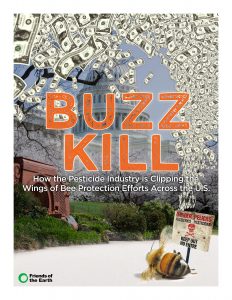 The investigation, Buzz Kill: How the Pesticide Industry is Clipping the Wings of Bee Protection Efforts Across the U.S., reveals an array of pesticide industry tactics to slow urgently needed pollinator protection measures at federal and state levels. The report details how new state pollinator protection plans, many still unfinished, have been heavily influenced by pesticide industry interests. According to the report, industry is spending hundreds of thousands of dollars on lobbying to delay state and federal action on the chemicals they manufacture. As a result, state pollinator protection plans across the U.S. are falling short in several ways, including:
The investigation, Buzz Kill: How the Pesticide Industry is Clipping the Wings of Bee Protection Efforts Across the U.S., reveals an array of pesticide industry tactics to slow urgently needed pollinator protection measures at federal and state levels. The report details how new state pollinator protection plans, many still unfinished, have been heavily influenced by pesticide industry interests. According to the report, industry is spending hundreds of thousands of dollars on lobbying to delay state and federal action on the chemicals they manufacture. As a result, state pollinator protection plans across the U.S. are falling short in several ways, including:
- State pollinator protection plans currently provide more protections for pesticides and pesticide users than for bee keepers and bee colonies.
- Pesticide industry influence is pervasive throughout states’ legislative and regulatory planning efforts.
- Plans lack metrics to measure effectiveness, improvement or failure.
Industry giants, like Bayer, Syngenta and Monsanto, have long been known to influence shaping federal and state pesticide policies to their benefit. In what is known as the revolving door at federal agencies, employees of the U.S. Department of Agriculture (USDA) and the U.S. Environmental Protection Agency (EPA) have shuffled between regulatory agencies and pesticide companies. The pesticide industry also directly funds or influences science by donating to education initiatives and building strategic alliances with academics.
Buzz Kill  updates  FOE’s 2014 “Follow the Honey” report, which revealed how chemical companies Bayer, Syngenta and Monsanto employ deceptive tobacco-style public relations tactics to manufacture doubt about scientific findings on pollinator die-offs, and protect chemical industry sales and profits at the expense of bees and our environment.
However, in light of federal inaction and industry influence, beekeepers, activists and concerned individuals are gearing up the celebrate pollinators and call for stronger protections this Pollinator Week which run from June 20-26, 2016.
Get Involved this Pollinator Week:
Made by Pollinators Campaign
Select restaurants in the DC-area will celebrate pollinator week by identifying ingredients that are pollinator dependent and showcasing the importance of pollinators to our food system. These restaurants also support local, organic and sustainable practices that take into account whole food and ecological systems. Given that every one in three bites of food is reliant on pollination, the campaign will educate the public on the importance of pollinators and ways to become more involved in protecting bees and other pollinators. For more information, visit www.beeprotective.org
Participating restaurants include:
Busboys and Poets
1025 5th St NW (and at other select locations)
Founding Farmers
1924 Pennsylvania Ave NW, Washington, DC 20006 (and at other select locations)
Lavagna
539 8th St SE, Washington, DC 20003
Tabard Inn
1739 N St NW, Washington, DC 20036
Restaurant Nora
2132 Florida Ave NW, Washington, DC 20008
Keep the Hives Alive Tour
As part of nationwide efforts to raise awareness about the decline of honey bees and other pollinators, the Keep the Hives Alive tour will travel the country urging Congress, EPA, and USDA to take real action to protect these critical species from toxic pesticides. The tour is organized by beekeepers, farmers, farmworkers, scientists and advocates and will stop in South Dakota, Minnesota, Michigan, Pennsylvania, North Carolina and Washington, DC before and during National Pollinator Week, June 13-23. Beekeepers will drive a bee truck between each stop, with a display of dead bees to demonstrate one beekeepers loss.
Please participate if you are located near any of the stops on the tour!
Use Facebook event pages to get more involved:
o    Lewisburg, Pennsylvania: Hackenburg Apiaries, June 18th
o    Research Triangle Park, North Carolina: Bayer Headquarters, June 20th
o    Washington, DC: EPA Headquarters, June 22nd.
Other ways to get involved for Pollinator Week and beyond:
Declare your garden, yard, park or other space as pesticide-free and pollinator friendly.
You can pledge your green space as pesticide-free and pollinator-friendly this week. It does not matter how large or small your pledge is, as long as you contribute to the creation of safe pollinator habitat.  Sign the pledge today. Need ideas on creating the perfect pollinator habitat? The  Bee Protective Habitat Guide  can tell you which native plants are right for your region.
Become a BEE Protective Ambassador  on your college campus. This project taps into enthusiastic environmental activists on college campuses throughout the country wishing to make a positive impact on the health of local pollinators and other wildlife. Student activists can pledge their campus or student organization to become ambassadors which involves creating pollinator habitat on campus, and working to change harmful pesticide use policies on campus.
Support pollinator friendly legislation. Ask your U.S. representative to support the re-introduced  Saving America’s Pollinator Act  (SAPA). This is a bill that would suspend the use of neonicotinoid pesticides until a full review of scientific evidence and a field study demonstrates no harmful impacts to pollinators.  Contact your Representative now.
Support retailers that are providing safer alternatives. Local ACE franchises are already proving that hardware stores don’t need to sell neonics or any other toxic pesticides in order to be financially successful. Eldredge Lumber and Hardware and Kittery ACE of York, Maine are  consciously stocking their shelves with organic compatible products, and providing seeds and nursery plants that are not treated by bee-toxic chemicals. Visit your local hardware or garden retailer and ask them to also to stop selling neonicotinoids and other bee-toxic pesticides, and source more organic alternatives, or give them a call today! You can also find your own source of organic seeds and plant starts by going to Beyond Pesticides’  Pollinator Friendly Seed and Nursery Directory.
Tell EPA to do more for pollinators. EPA has acknowledged that pesticides are a problem, but little meaningful action has been done to reverse pollinator declines. Bees need real protections from toxic pesticides now. It’s time for EPA to get serious about protecting bees by suspending neonicotinoids.
Make Change Happen in Your Community. Â Armed with allies and resources from your video screening party, go to your elected official and ask them to introduce the Model Pollinator Resolution and/or our Model Lawns and Landscapes policy.
–Get the  Model Community Pollinator Resolution  here, and our  Model Lawns and Landscapes Policy  here.
–For more information, see our  BEE Protective webpage, or  get in touch with us.
All unattributed positions and opinions in this piece are those of Beyond Pesticides.
Source: FOE press release
Posted in Agriculture, Alternatives/Organics, Announcements, National Politics, Pesticide Regulation, Pollinators, Take Action, Wildlife/Endangered Sp. by: Beyond Pesticides
No Comments
 The study, “Neonicotinoid-contaminated pollinator strips adjacent to cropland reduce honey bee nutritional status,” finds that pollinator habitat adjacent to agricultural areas not only becomes a source for pesticide, especially neonicotinoid, exposures, but also poses significant risk to honey bees. The authors, Christina Mogren, PhD, and former USDA entomologist, Jonathan Lundgren, PhD, initially sought to study whether increasing forage by planting pollinator habitat in an agricultural-dominated region would serve to buffer against the harmful effects of plant-incorporated pesticides. However, the authors note that it soon became apparent that the unintended consequence was that these planted habitats become a source for neonicotinoid exposure.
The study, “Neonicotinoid-contaminated pollinator strips adjacent to cropland reduce honey bee nutritional status,” finds that pollinator habitat adjacent to agricultural areas not only becomes a source for pesticide, especially neonicotinoid, exposures, but also poses significant risk to honey bees. The authors, Christina Mogren, PhD, and former USDA entomologist, Jonathan Lundgren, PhD, initially sought to study whether increasing forage by planting pollinator habitat in an agricultural-dominated region would serve to buffer against the harmful effects of plant-incorporated pesticides. However, the authors note that it soon became apparent that the unintended consequence was that these planted habitats become a source for neonicotinoid exposure.








 species interactions, and potentially create trophic cascades, situations where the interaction between predators and prey in the food web becomes imbalanced. For example, a predacious fish may, under normal circumstances, exert a population control on smaller fish that feed on insects that eat algae. Decreased activity and reduced predation among predacious fish can result in an explosion of smaller fish, which can then result in an overconsumption of algae-eating insects, ultimately leading to an increase in algae in an aquatic area. These difficult to perceive interactions underscore the call from the authors of the study for future research to better understand how pesticide-induced changes in behavior can alter the fitness, populations, and make-up of aquatic communities and ecosystems.
species interactions, and potentially create trophic cascades, situations where the interaction between predators and prey in the food web becomes imbalanced. For example, a predacious fish may, under normal circumstances, exert a population control on smaller fish that feed on insects that eat algae. Decreased activity and reduced predation among predacious fish can result in an explosion of smaller fish, which can then result in an overconsumption of algae-eating insects, ultimately leading to an increase in algae in an aquatic area. These difficult to perceive interactions underscore the call from the authors of the study for future research to better understand how pesticide-induced changes in behavior can alter the fitness, populations, and make-up of aquatic communities and ecosystems.

 Title IV, Section 437 of H.R. 5538 states that, “None of the funds made available by this or any other Act may be used to implement or enforce, or to require States to implement or enforce, the provisions of
Title IV, Section 437 of H.R. 5538 states that, “None of the funds made available by this or any other Act may be used to implement or enforce, or to require States to implement or enforce, the provisions of  In 2014 the state announced its
In 2014 the state announced its  The lawsuit, filed  by Ecojustice on behalf of  The David Suzuki Foundation, Friends of the Earth Canada, Ontario Nature, and the Wilderness Committee, argues that pesticide products containing two neonicotinoids,
The lawsuit, filed  by Ecojustice on behalf of  The David Suzuki Foundation, Friends of the Earth Canada, Ontario Nature, and the Wilderness Committee, argues that pesticide products containing two neonicotinoids,  An efficient mosquito management strategy emphasizes public awareness, prevention, and monitoring methods. However, if these methods are not used properly or in time, communities must determine if they should risk exposing vulnerable populations to potentially harmful diseases caused by mosquitoes or to chronic or deadly illnesses caused by pesticides.
An efficient mosquito management strategy emphasizes public awareness, prevention, and monitoring methods. However, if these methods are not used properly or in time, communities must determine if they should risk exposing vulnerable populations to potentially harmful diseases caused by mosquitoes or to chronic or deadly illnesses caused by pesticides. UM researchers, Cara Nelson, Ph.D. and Viktoria Wagner, Ph.D., along with two researchers from Canada, looked at government agencies and agricultural statistics companies in the U.S., Canada, and Mexico to find their data. The study found that the government agencies in Canada and Mexico kept no archived database of herbicide usage for invasive plant management. In the U.S., five out of seven agencies that were contacted by the researchers tracked herbicide usage, and only four of those agencies shared their data. These agencies include the Bureau of Indian Affairs, Bureau of Land Management, Fish and Wildlife Service, and National Park Service. The U.S. Forest Service, which oversees 193 million acres in the U.S., declined to share its data on herbicide use. The report found that even the agencies that did share their data did not consistently archive information on the effectiveness of the herbicide usage, the costs associated with usage, or make the information publicly available.
UM researchers, Cara Nelson, Ph.D. and Viktoria Wagner, Ph.D., along with two researchers from Canada, looked at government agencies and agricultural statistics companies in the U.S., Canada, and Mexico to find their data. The study found that the government agencies in Canada and Mexico kept no archived database of herbicide usage for invasive plant management. In the U.S., five out of seven agencies that were contacted by the researchers tracked herbicide usage, and only four of those agencies shared their data. These agencies include the Bureau of Indian Affairs, Bureau of Land Management, Fish and Wildlife Service, and National Park Service. The U.S. Forest Service, which oversees 193 million acres in the U.S., declined to share its data on herbicide use. The report found that even the agencies that did share their data did not consistently archive information on the effectiveness of the herbicide usage, the costs associated with usage, or make the information publicly available. “The American people have a right to know what they’re eating,” said Senator Bernie Sanders (I-VT), who vowed to put a hold on the bill if they didn’t reach the 60 votes needed for cloture during a
“The American people have a right to know what they’re eating,” said Senator Bernie Sanders (I-VT), who vowed to put a hold on the bill if they didn’t reach the 60 votes needed for cloture during a  According to the European Commission
According to the European Commission Many of the residents were with an community  group called
Many of the residents were with an community  group called  fter the European Food Safety Authority (EFSA) Â
fter the European Food Safety Authority (EFSA)   The Department of Recreation and  Parks (DRP) manages approximately 10,000 acres of parkland within Howard County. According to the new policy and procedure, DRP is restricting the use of neonicotinoids, “due to recent research suggesting that there is a link between pesticides that contain neonicotinoids negatively effecting populations of pollinator species, such as; honeybees, native bees, butterflies, moths and other insects.” Neonics were often used on parklands for grubs on turf, Japanese beetles on trees,  and aphids on flowers and are now prohibited on all County parkland, including sports fields, garden plots, golf course and open space. Exemptions exist for agricultural uses and invasive pest infestations.
The Department of Recreation and  Parks (DRP) manages approximately 10,000 acres of parkland within Howard County. According to the new policy and procedure, DRP is restricting the use of neonicotinoids, “due to recent research suggesting that there is a link between pesticides that contain neonicotinoids negatively effecting populations of pollinator species, such as; honeybees, native bees, butterflies, moths and other insects.” Neonics were often used on parklands for grubs on turf, Japanese beetles on trees,  and aphids on flowers and are now prohibited on all County parkland, including sports fields, garden plots, golf course and open space. Exemptions exist for agricultural uses and invasive pest infestations.  example, Ben & Jerry’s ice cream and Cabot’s cheddar cheese,” says Dr. Allen. “This is about more than the consumer’s right to know. It’s also about the impact GMO-centered agriculture is having on Vermont’s environment and wildlife, its role in the continued monopolization of the food supply, and the roadblocks it creates in the path toward a truly regenerative, eco-sensitive, and socially-just form of agriculture in the state.”
example, Ben & Jerry’s ice cream and Cabot’s cheddar cheese,” says Dr. Allen. “This is about more than the consumer’s right to know. It’s also about the impact GMO-centered agriculture is having on Vermont’s environment and wildlife, its role in the continued monopolization of the food supply, and the roadblocks it creates in the path toward a truly regenerative, eco-sensitive, and socially-just form of agriculture in the state.” ingredients in the food we eat. While proponents this DARK deal say it will require a mandatory national labeling scheme, the Senate bill includes no mandatory standards. Instead, it preempts Vermont’s law through a discretionary process that will be determined by a future Secretary of Agriculture. It also does very little to ensure consumers will actually have access to this information because the bill would allow for a range of labeling options that will not warn consumers – quick response (QR) codes, 800 numbers, websites and on-package labeling. This approach leaves poorer Americans at a disadvantage in receiving this information, as QR code labels require the use of a smartphone to read. Allowing food companies to decide how to label all but ensures they will work to misinform the public about their products; we have already seen
ingredients in the food we eat. While proponents this DARK deal say it will require a mandatory national labeling scheme, the Senate bill includes no mandatory standards. Instead, it preempts Vermont’s law through a discretionary process that will be determined by a future Secretary of Agriculture. It also does very little to ensure consumers will actually have access to this information because the bill would allow for a range of labeling options that will not warn consumers – quick response (QR) codes, 800 numbers, websites and on-package labeling. This approach leaves poorer Americans at a disadvantage in receiving this information, as QR code labels require the use of a smartphone to read. Allowing food companies to decide how to label all but ensures they will work to misinform the public about their products; we have already seen  According to
According to  Meanwhile, the Pollinator Partnership, an organization closely affiliated with the chemical industry (Bayer, Syngenta, BASF, CropLife, have all been previously
Meanwhile, the Pollinator Partnership, an organization closely affiliated with the chemical industry (Bayer, Syngenta, BASF, CropLife, have all been previously 



 U.S. District Judge Jacqueline Scott Corley of the Northern District of California found that USDA’s National Organic Program (NOP) operated without the required notice and comment. She explained, “the reach of the Agency’s  new rule stretches beyond bifenthrin and instead allows green waste or green waste compost used in organic production to contain any synthetic pesticide of which bifenthrin is just one example.” The plaintiffs in the case are Center for Environmental Health (CEH), Center for Food Safety (CFS), and Beyond Pesticides.
U.S. District Judge Jacqueline Scott Corley of the Northern District of California found that USDA’s National Organic Program (NOP) operated without the required notice and comment. She explained, “the reach of the Agency’s  new rule stretches beyond bifenthrin and instead allows green waste or green waste compost used in organic production to contain any synthetic pesticide of which bifenthrin is just one example.” The plaintiffs in the case are Center for Environmental Health (CEH), Center for Food Safety (CFS), and Beyond Pesticides.  EC’s new rules endorse the World Health Organization’s definition of endocrine disrupting chemicals (EDC). The WHO defines an endocrine disruptor as “an exogenous substance or mixture that alters function(s) of the endocrine system and consequently causes adverse health effects in an intact organism, or its progeny, or (sub)populations,” However, the proposed regulations go little beyond defining the term. “The WHO definition is not a criteria, it is just a definition,” said Andreas Kortenkamp, PhD to
EC’s new rules endorse the World Health Organization’s definition of endocrine disrupting chemicals (EDC). The WHO defines an endocrine disruptor as “an exogenous substance or mixture that alters function(s) of the endocrine system and consequently causes adverse health effects in an intact organism, or its progeny, or (sub)populations,” However, the proposed regulations go little beyond defining the term. “The WHO definition is not a criteria, it is just a definition,” said Andreas Kortenkamp, PhD to 











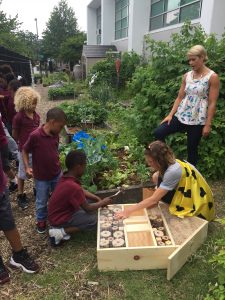

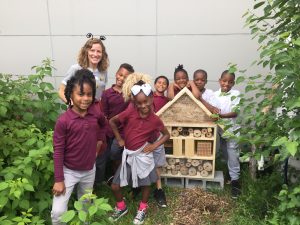



 The investigation, Buzz Kill: How the Pesticide Industry is Clipping the Wings of Bee Protection Efforts Across the U.S., reveals an array of pesticide industry tactics to slow urgently needed pollinator protection measures at federal and state levels. The report details how new state pollinator protection plans, many still unfinished, have been heavily influenced by pesticide industry interests. According to the report, industry is spending hundreds of thousands of dollars on lobbying to delay state and federal action on the chemicals they manufacture. As a result, state pollinator protection plans across the U.S. are falling short in several ways, including:
The investigation, Buzz Kill: How the Pesticide Industry is Clipping the Wings of Bee Protection Efforts Across the U.S., reveals an array of pesticide industry tactics to slow urgently needed pollinator protection measures at federal and state levels. The report details how new state pollinator protection plans, many still unfinished, have been heavily influenced by pesticide industry interests. According to the report, industry is spending hundreds of thousands of dollars on lobbying to delay state and federal action on the chemicals they manufacture. As a result, state pollinator protection plans across the U.S. are falling short in several ways, including:
